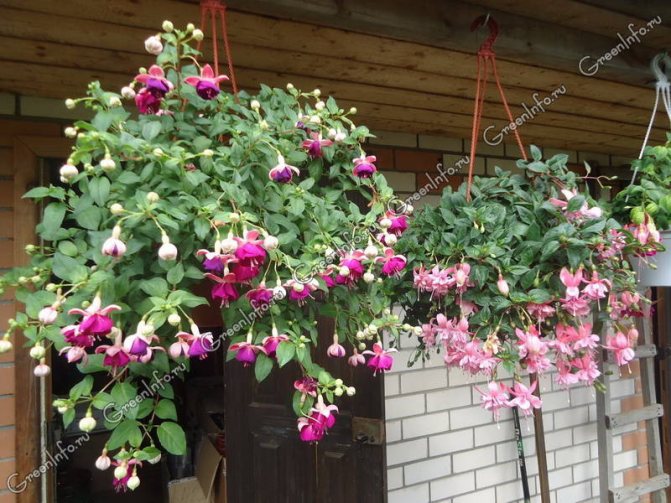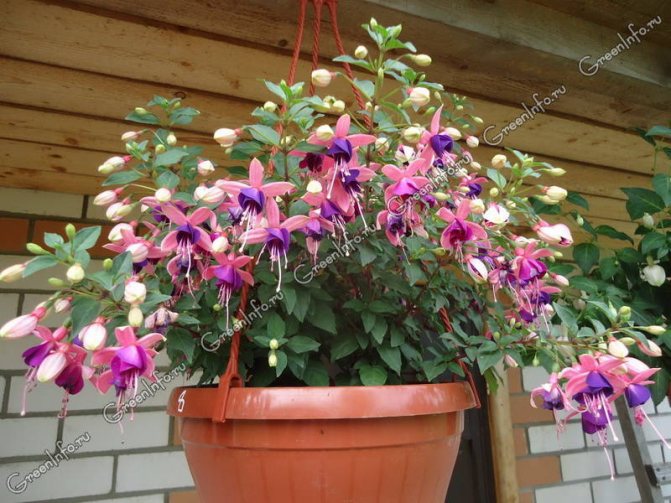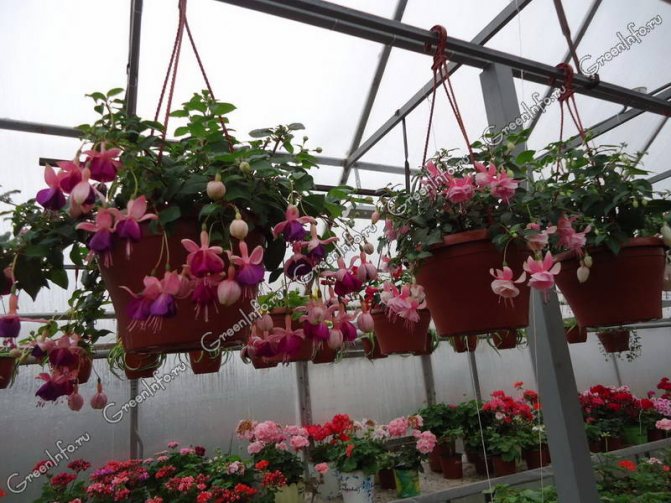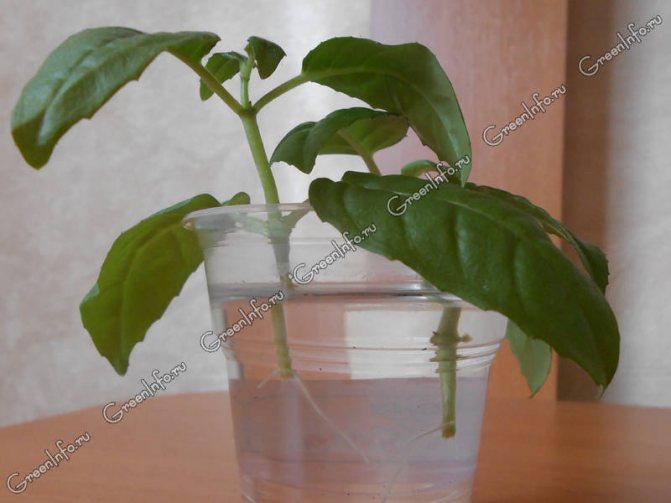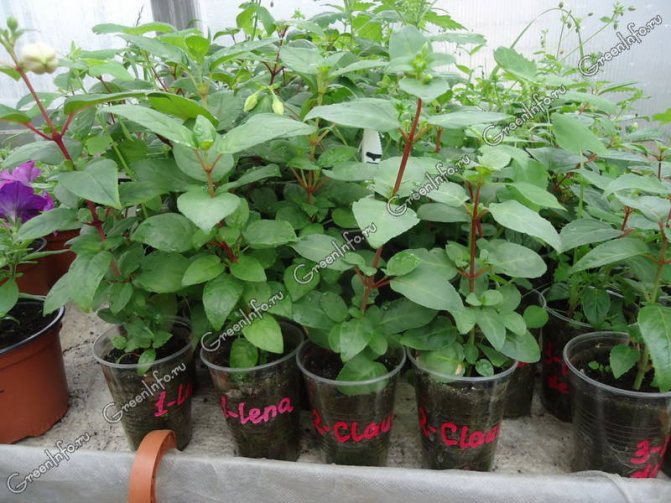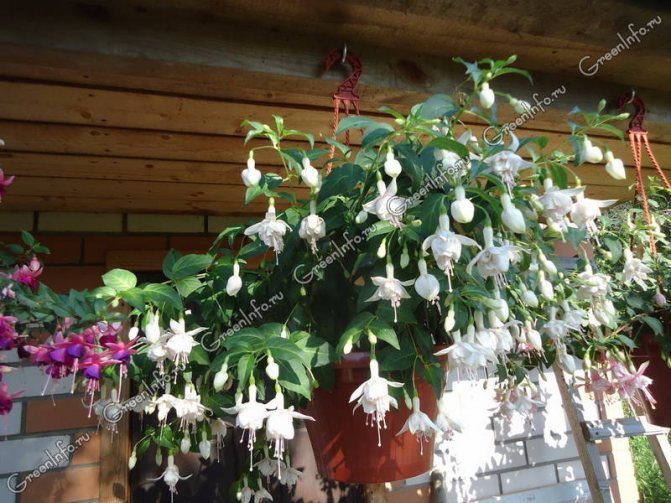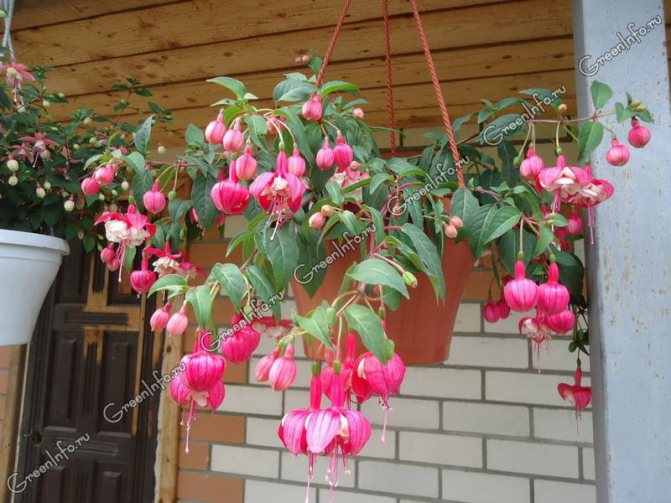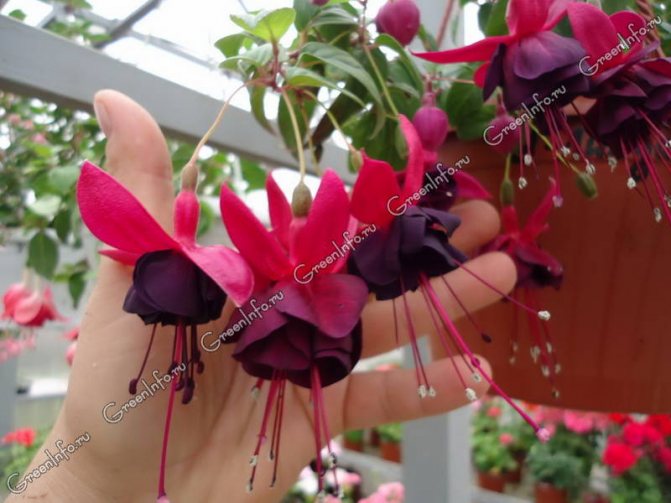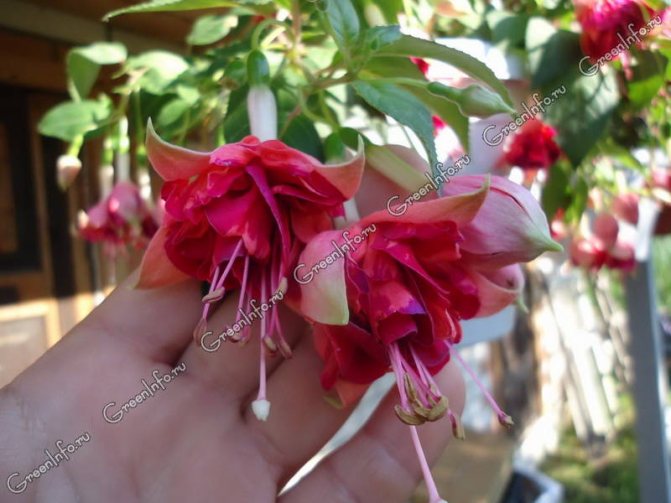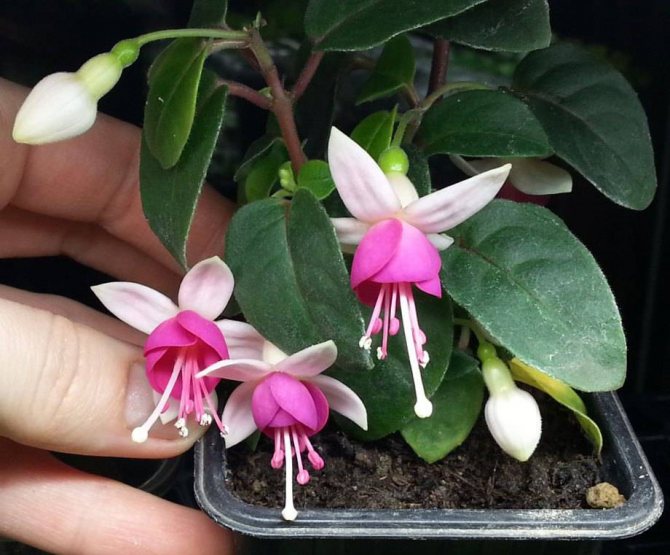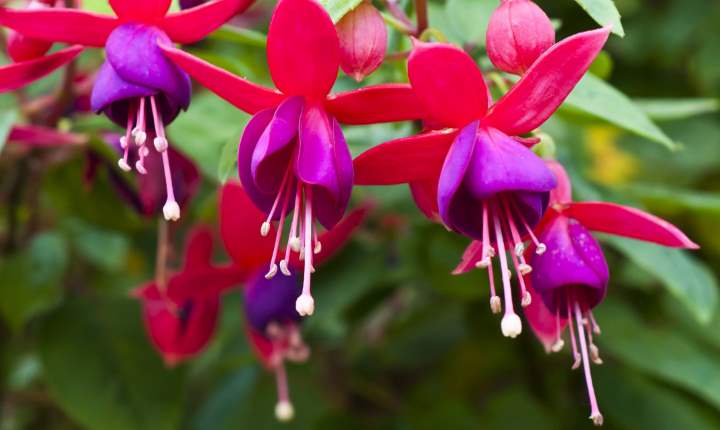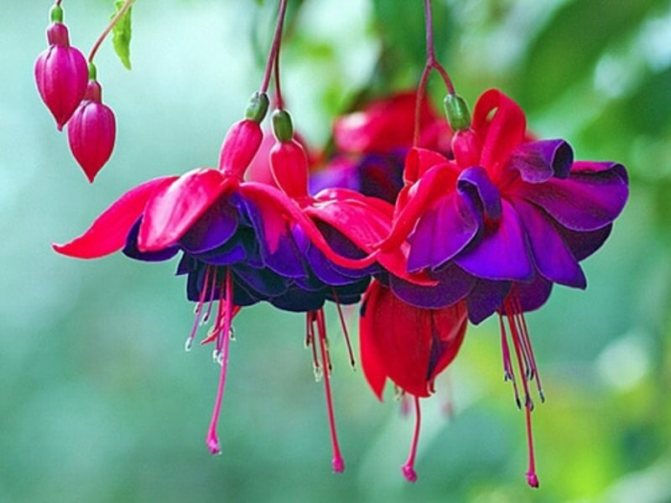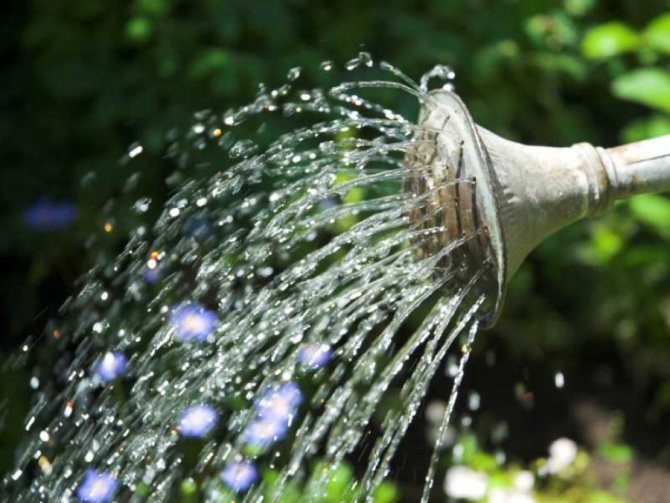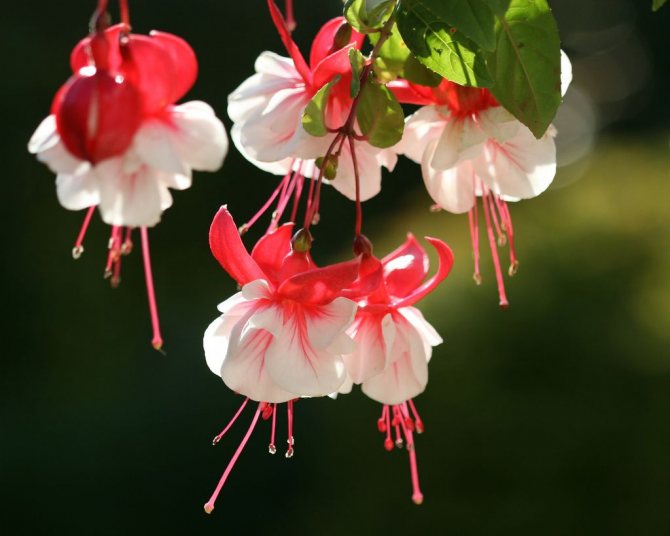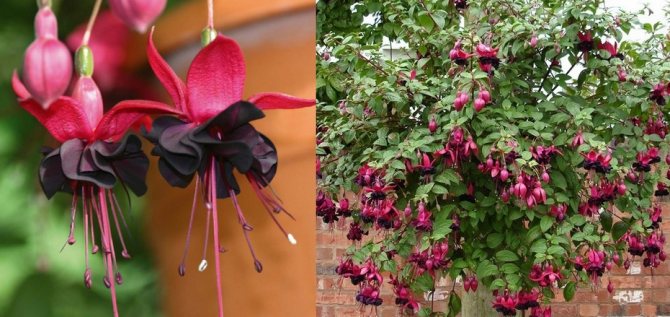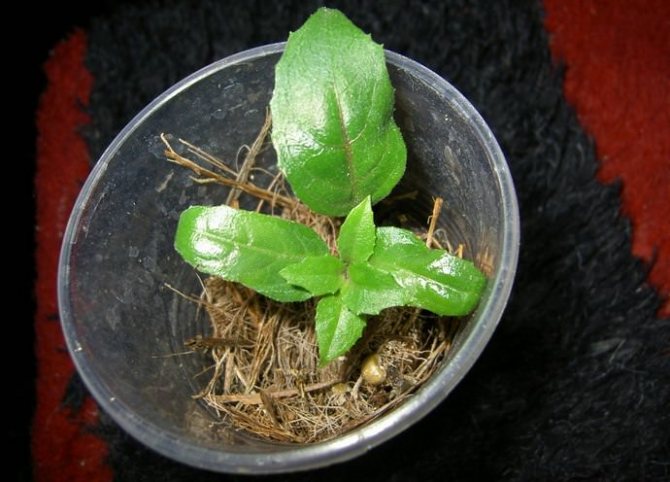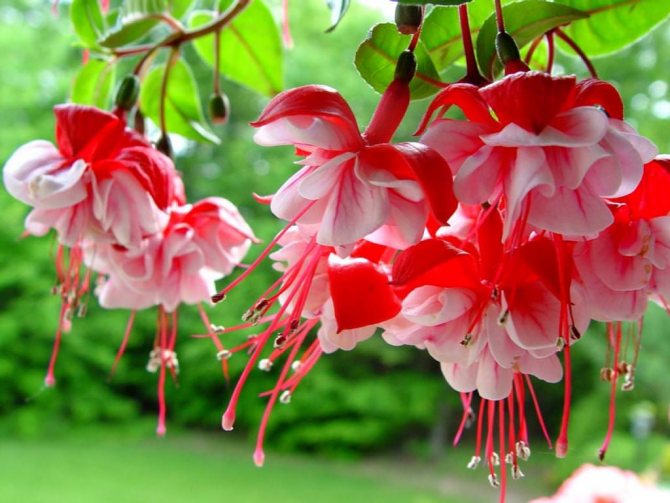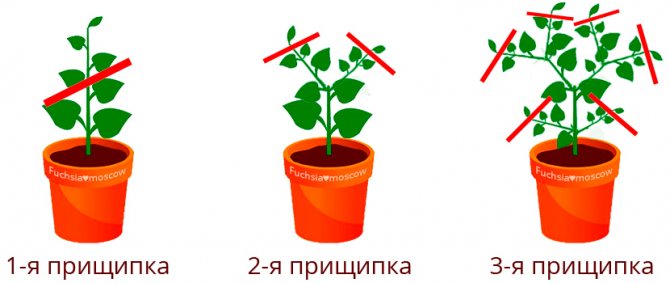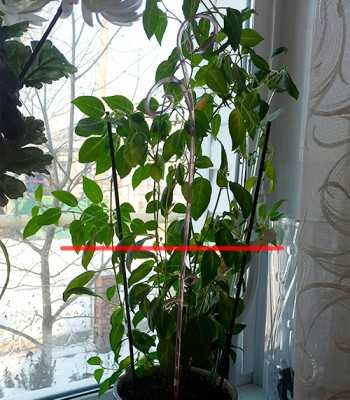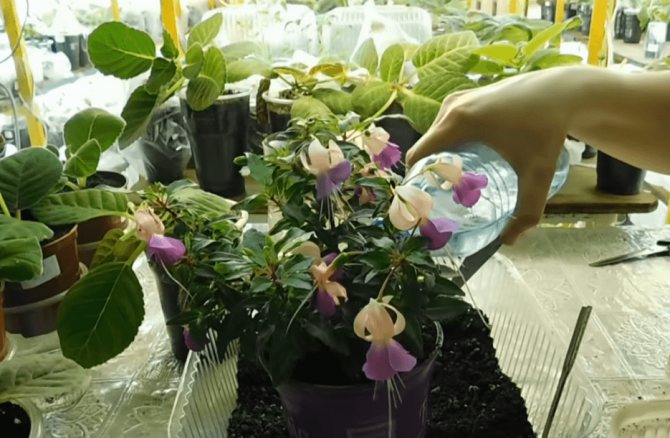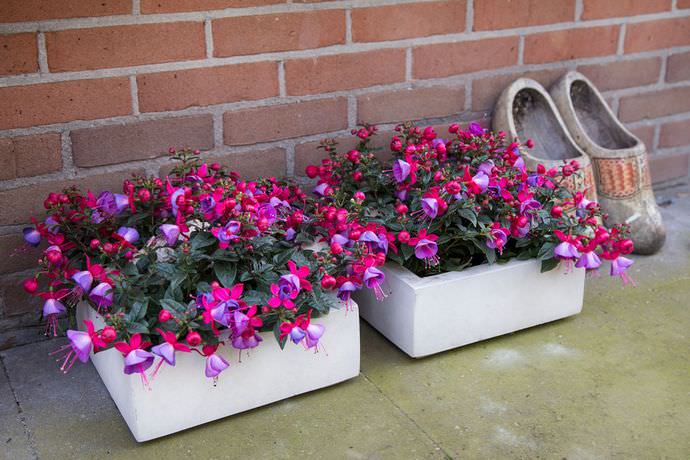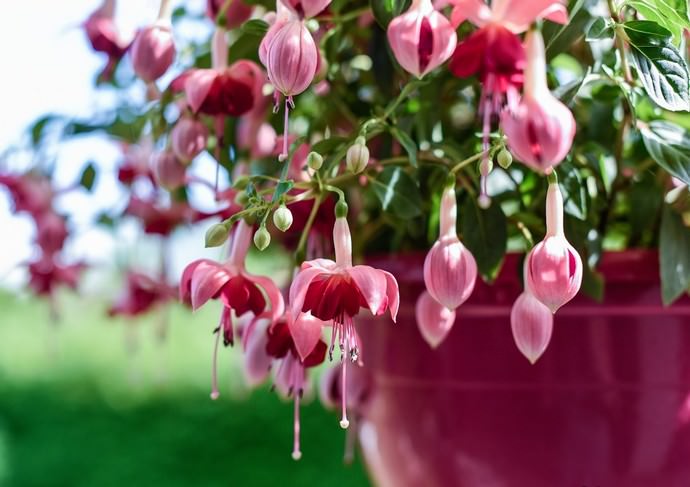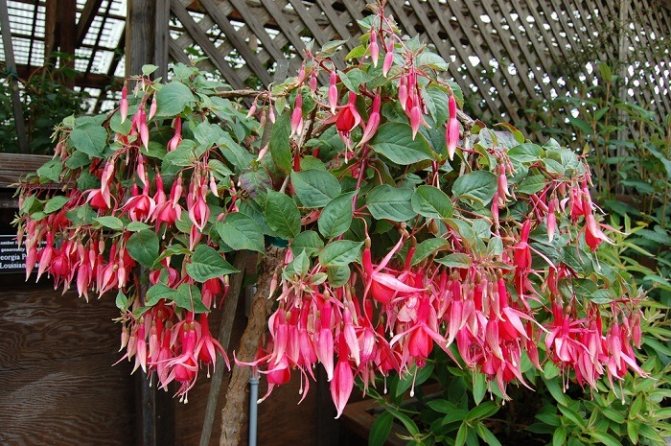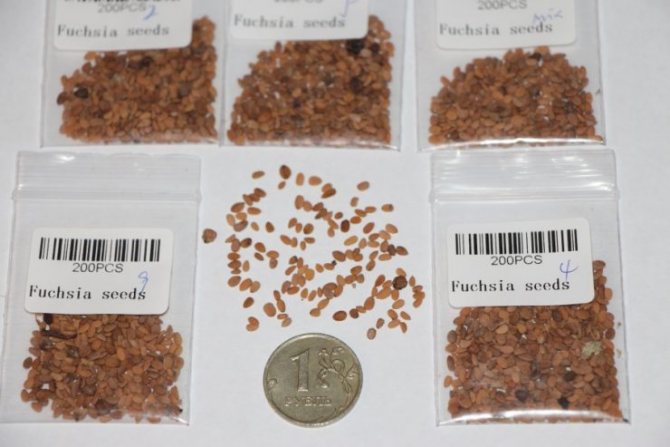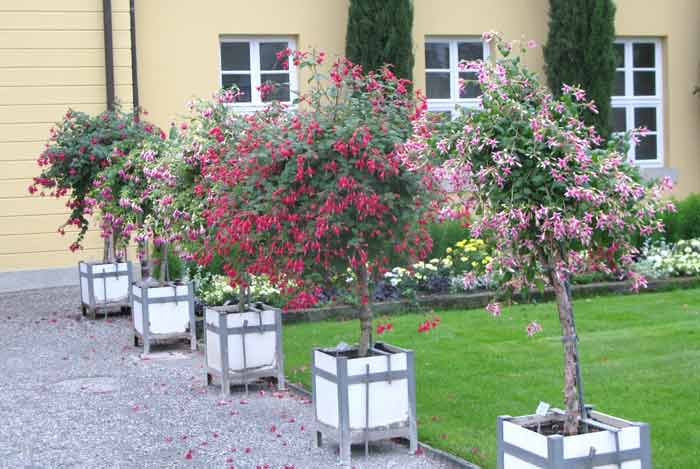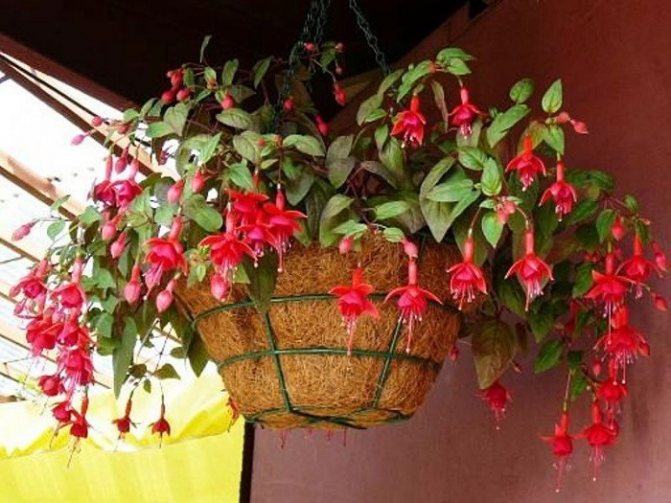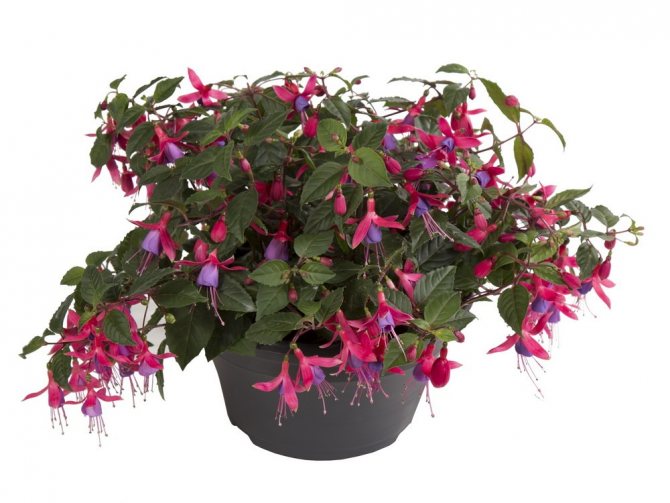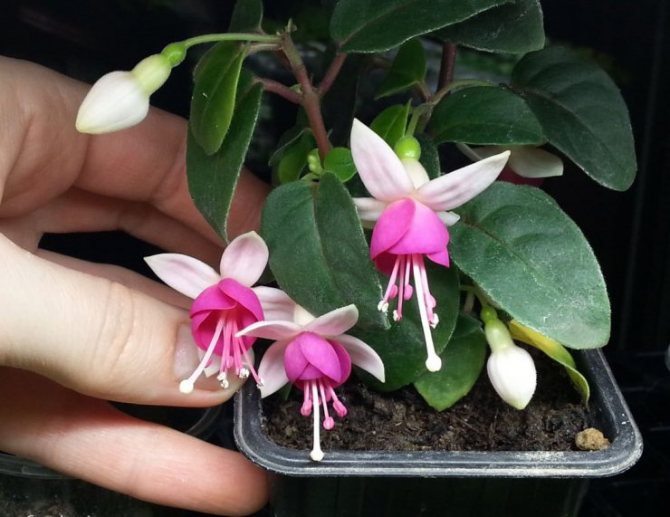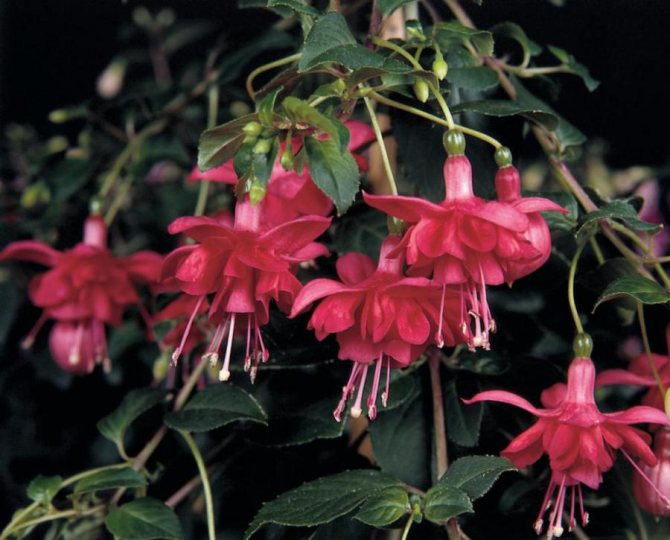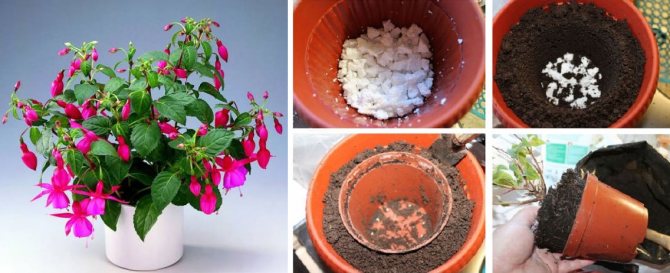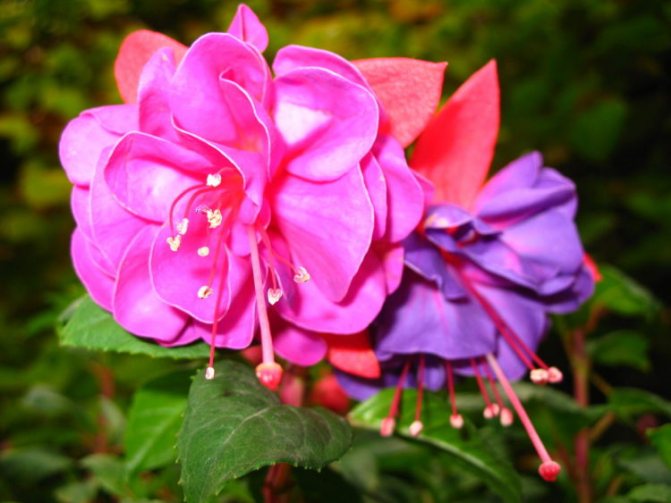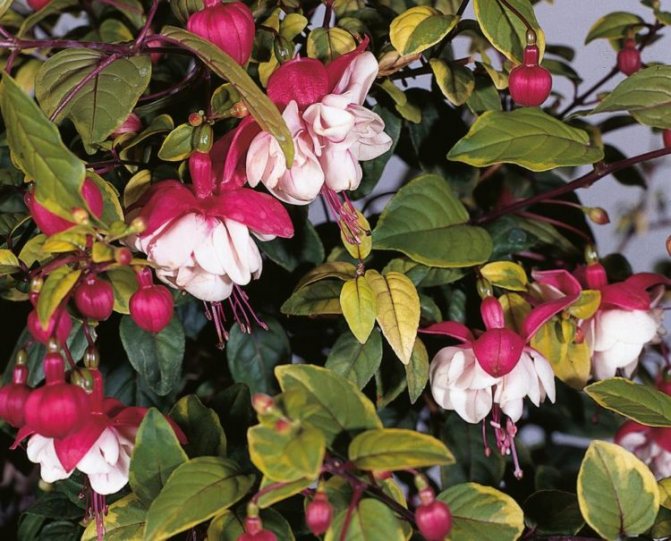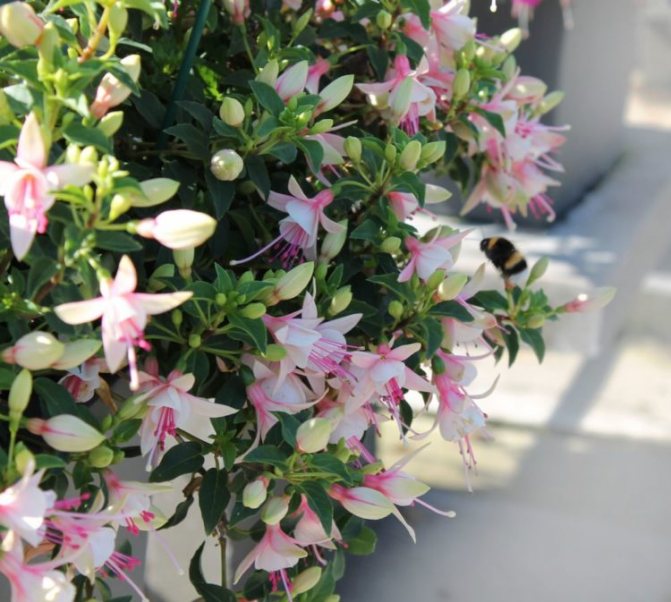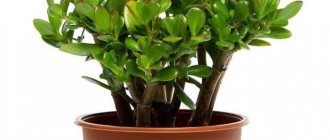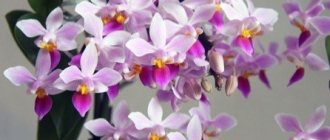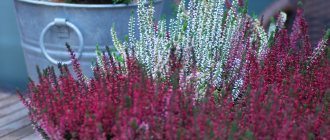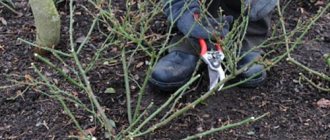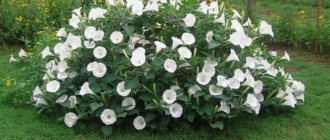Most of you know that the fuchsia flower is famous for its excellent decorative properties and extreme whimsicality to the conditions of its growth. Although experienced florists say that growing a fuchsia indoor flower is as easy as shelling pears and sheer pleasure. As a rule, soft female flowers are creeping, and male, energetic ones rush upward. By choosing the shape and external size of fuchsia, you can adjust the energies of the living space, which is very important when difficult events happen in the family. From the article you will learn how to prune fuchsia for the winter, when is it better to do it and how?
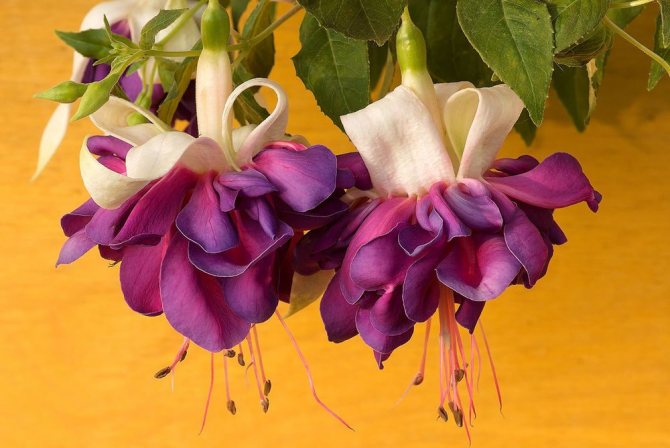
Cutting features
Choosing the season: when is the best time to start?
First you need to decide when it is best to prune fuchsia. Most often, this process is performed in the spring. It is worth pruning before new buds are formed.... Thus, the flowering will become lush and long lasting.
Can this be done in the fall and winter?
You can carry out autumn pruning of fuchsia, but only do it in late October - early November. This option is suitable for those gardeners who grow fuchsia as a houseplant (read about the nuances of growing fuchsia at home here).
Pruning in the fall takes place in a gentle mode. On each branch, remove those parts on which the peduncles were. Cut off the twigs to the first pair of stone buds from the top. When fuchsia still continues to bloom in the fall, it is better not to touch it, but to postpone this matter until winter.
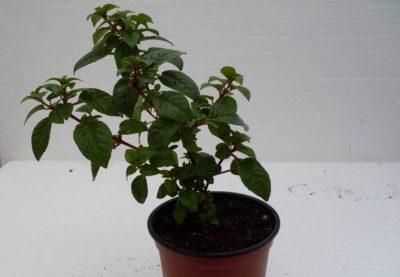

Carry out winter pruning for those plants in which flowering lasts until late autumn. Besides,
winter pruning must be done before sending the flower for wintering (read how to keep fuchsia in the basement and apartment in winter here).
Pruning should be strong, leaving shoots 15 cm long. If the crowns are already formed, then remove only weak shoots, thin out and shorten the remaining branches by 1/3 of their height. Subsequently, to form a standard tree in specific places, the shoots are pinched.
Instrument and disinfection
Use a sharp knife or garden shears to trim fuchsia. Before starting the process, one of the important points is the disinfection of garden tools. This will prevent the development of viral diseases, the transmission of which occurs with the sap of affected plants.
In the process of disinfection, various compounds are used that contain alcohol.... You can use alcohol-containing wipes, medical sprays or household products: chlorine, kerosene.
For lush bloom
It is from pruning that the flowering intensity depends. The later the procedure is carried out, the later the fuchsia will begin to bloom. It is desirable to carry out pruning 2 times a year - before wintering and in early spring. Autumn pruning is preventive in nature, since in its process damaged, frail and thin twigs are removed.
Spring pruning is done in February-March. Its main task is to form a beautiful crown with a large number of young shoots, at the ends of which buds are formed.
The pruning process has the following features:
- The first step is to remove the small frail twigs. On them, most likely, there will be no flowering, and if it does, it will be very weak.
- Now you can move on to removing dry and very thin twigs.
- Cut off those shoots that are directed to the center. This will prevent the bush from becoming too thick.
- When pruning shoots, take into account that the crown is of the correct shape. Make a cut at a distance of 1.5-2 cm from the node.
Spider mite on fuchsia. What to do?
The optimal conditions for the appearance of a red spider mite is warm and dry air in the apartment. The main symptom of the appearance of the pest is a gray coating on the inside of the fuchsia leaves, many small black dots and cobwebs.
It is unlikely that it will be possible to remove this insect by washing the plant. That is why it is best to use chemicals such as Fufanon.
Important!
When using any chemicals, you must act strictly following the instructions.
A complete disinfection of all auxiliary tools that are used to care for indoor flowers is required, as well as immediate isolation of the diseased plant. This is the only way to avoid an epidemic and the death of other flowers.
A dancing flower or a ballerina is called fuchsia. Once you see it, this plant is hard to forget. The original bright flowers really float in the air, like ballerinas in a bewitching dance.
In Russia, some people call fuchsia "Grandmother's plant"
,
"Japanese lantern"
, and to someone her flowers resemble the fluttering of exotic butterflies.
For Europeans, fuchsia was discovered in 1665 in the foothills of Santo Domingo during his third expedition by a French scientist who was called the king of botanists - Charles Plumier
, artist, writer, author of many scientific works, which were highly appreciated and used by Karl Linnaeus.
Charles Plumier named the plant after a German botanist and physician Leonard von Fuchs
, head of the medical department at the University of Touring, who was born in Bavaria in 1501.
The full name of fuchsia in Latin is Fuchsia Triphylla Flore Coccinea
.
In the XYII century, fuchsia came to Great Britain and then spread throughout Europe.
Fuchsia fascinated not only botanists, but also alchemists. Thus, the Dutch society of alchemists, called the "Brotherhood of the Rose and the Cross", attributed magical properties to it.
In a cup of fuchsia, which consisted of four cross-shaped lobes, alchemists saw, and opposite leaves, arranged in pairs crosswise, reminded them of the magical signs of a cross and a rose.
The Rosicrucians dedicated fuchsia to the goddess of love, seeing in a flower such qualities so valued by men in women as grace, tenderness, softness, warmth ...
Fuchsia
- an evergreen or deciduous shrub from the family of onagrikovy or primrose.
In nature, about 100 species of fuchsia grow, which, in addition to South America, are common in New Zealand and Polynesia. In their homeland, fuchsias are not only shrubby, but also tree-like and carpet.
In indoor conditions, fuchsias look like bushes, ampelous plants and, less often, standard trees 40-100 cm tall.
Young stems and petioles of fuchsia have a reddish tint.
Leaves are green or slightly reddish, small, on long oval or ovoid petioles, pointed, with denticles along the edges.
Single flowers on thin legs hang down and are collected in inflorescences - brushes.
Each individual fuchsia flower consists of a calyx with four pointed, bent sepals and a bell-shaped corolla, which can be simple, semi-double and double. Stamens and a pistil hang from under the corolla.
Flowers can be painted in white, pink, red, purple, there are fuchsias with a double color. The sizes of different fuchsia varieties are different.
Blooming of all fuchsias is long lasting - from spring to late autumn.
Many amateur flower growers, who are not indifferent to fuchsias, collect whole collections from them, choosing plants in such a way that they can enjoy their flowering almost all year round.
During flowering, fuchsia not only cannot be rearranged to another place, but even just move the pot. Otherwise, the plant will drop both flowers and buds that have not yet opened.
Fuchsia fruits are dark red, from which jam and marmalade are prepared. However, fruiting for domestic fuchsias is a heavy burden, often the plant can be depleted after it. Therefore, most growers remove faded flowers.
And only super-experienced specialists allow themselves the luxury of enjoying the taste of fuchsia fruits and leaving them for seed reproduction.
Before the revolution, fuchsias were very popular in Russia, but the new government, together with the geraniums on the window, were called symbols of the bourgeoisie. And only in the 70s and 80s of the last century, love for fuchsias in our country flared up with renewed vigor.
Fuchsia is a fairly unpretentious houseplant.
It can even grow on the northern windows, but the most abundant flowering occurs in fuchsias standing on the western and eastern windows.
The southern windows are too sunny for her. Light partial shade, diffused light are the best friends of this plant.
Fuchsias prefer a temperature of + 20-25C. Fuchsias do not tolerate temperatures above + 27-28C, on hot days they need to be hidden in the shade or removed to the back of an apartment or office. In this case, the pots should be wrapped in light-colored paper.
The bright sun is contraindicated for fuchsias. In the heat around the pots, experts advise to lay out ice cubes, specially frozen for this in the freezer.
Fuchsias should not be grown in plastic pots, only ceramic or earthen pots, so that the roots of the plants do not heat up. The pots should not be small, appropriate for the size of the plant.
In the summer, if possible, fuchsias are taken out and buried in the ground together with the pots. They look very beautiful in the openwork shade of bushes and trees.
In the summer, fuchsias need abundant watering. However, there should be no stagnation of water.
In winter, watering is moderate, but the earthen coma should not be allowed to dry out.
In summer, fuchsias need splashing and bathing.
From spring, from about the end of March - beginning of April until autumn, fuchsias are fed with mineral and organic fertilizers bought in a store.
Fuchsias are suitable and fertilizing once a week with liquid fertilizers for balcony flowers. In winter, the plant is not fed.
The best temperature for wintering fuchsias is + 10C, but plants also winter at room temperature, only they often shed their leaves.
In a heated room in winter for fuchsias, you need to create increased air humidity. Place containers with water next to it, often sprinkle around the plant.
For the winter, the stem of the plant is shortened by 1/3, removing the remaining buds and flowers to give the fuchsia to gain strength.
Fuchsias are not picky about the soil. Drainage from expanded clay or small pebbles is placed on the bottom of the pot. An earthen mixture is prepared from leaf or turf soil, peat and sand in a ratio of 3: 2: 1. You can add a little bit.
Fuchsias are transplanted in early spring, after a dormant period.
The transplanted plants are placed in a well-lit place, cut off, leaving shoots 10-15 cm long, well watered and sprayed.
Many amateurs plant fuchsias in open ground at the end of May - June, where they bloom profusely until September-October.
Fuchsias endure light autumn night frosts without harm to themselves.
In this case, the plants are dug up in autumn, transplanted into pots or containers, cut and kept at a temperature of + 5-10C.
At a temperature of + 15-20C, fuchsias bloom in winter, especially when artificially illuminated.
Fuchsias propagate by cuttings in March-April and summer.
Cuttings, about 10 cm long, taken from slightly lignified shoots, are planted in a mixture of sand and peat, or a layer of drainage is poured into a bowl, then a layer of soil, and on top - coarse river well-washed sand, covered with a jar, moistened, sprayed daily warm water, wiping the inside of the jar with a cloth, pinch the top of the handle.
Some root cuttings in a jar of water.
Fuchsias are sometimes attacked by aphids. To combat it, the plant is wiped with a cotton swab dipped in alcohol and treated with an insecticide (actellik, 1 ampoule per 1 liter of water). Processing until the plant is completely cured is carried out every 3 days.
The same treatment with actellic is carried out when a whitefly attacks. They also use the drug "Aktar". Use it strictly according to the attached instructions and in the fresh air.
For prevention, the crown of plants is washed with a lukewarm shower with a pot covered with a film.
Spider mites are destroyed by spraying and washing the leaves, especially from the underside, with a shower stream or infusion of onion peels.
Tobacco infusion is also suitable.
Autumn pruning also helps to get rid of pests.
Fuchsia is a very kind and optimistic plant, it inspires hope and lifts the spirit, does not give despair and attracts all good things under the roof of a house or office.
I share the beauty! Good mood, rich harvest and sunshine to everyone!
And a little more information about fuchsia pests and measures to combat them!
Whitefly
The most common pest of fuchsia is the whitefly.
These are small (up to 2mm) white flies. They got their generic name because both pairs of wings are covered with white pollen. Outwardly they look like a microscopic moth. Large colonies of these insects, adults and larvae live on the lower surface of the leaf. They are easy to spot because when shaking the foliage of the plant, the flies fly up en masse.
The larva has 4 instars. In the first, it is mobile, with legs and antennae. Its task is to find a suitable place to attach it on the sheet.
In subsequent instars, the larva is already immobile: it firmly "sticks" to the leaf and sucks out the juice through the stylet immersed in the tissue. During this period, the larva resembles a transparent flat scale.
During mass reproduction, such scale larvae completely cover the leaves. The consequence of this lesion is yellowing of the leaves, shredding of flowers, drying of the shoots. Like other sucking insects, the whitefly secretes sweet honeydew on which sooty fungi develop. Whitefly is also dangerous as a carrier of viruses - pathogens of plant diseases.
At the fourth instar, the larva turns into a pupa. It changes greatly, becomes convex, opaque, covered with waxy secretions on top.
After molting, the pupa turns into an adult insect.
There are several types of whitefly: citrus, greenhouse, tobacco.
Citrus whitefly damages subtropical trees and shrubs in the south of Krasnodar Territory and in greenhouses.
The greenhouse whitefly is a species of tropical origin. It does not overwinter outdoors. But in greenhouses it hurts all year round. It gives 5-7 generations per year.
Tobacco (or cotton) - outwardly does not differ from the greenhouse, but has some features in development. Differs in high resistance to pesticides.
Control measures
Good results are obtained by spilling all plants 3-4 times with the preparation "Aktara". (4g of the drug per 5 liters of water)
Plant sap becomes fatal to pests. Repeated treatment is necessary, because after treatment, only those stages of the pest that feed on the plant sap die.
It is better to alternate treatments with Aktara and Confidor preparations. Since the use of only one drug can contribute to the emergence of a resistant pest generation.
Also well complements insecticides washing plants with soapy water.This solution should be left on the plant for about 1 hour, and then rinse the plant with lukewarm water, manually washing off the larvae on the underside of the leaves.
To reduce the number of adults, you can use yellow sticky strips-traps, where insects enter, being disturbed by shaking the foliage. But only the use of insecticides gives a guaranteed result.
How to properly care after the procedure?
Lighting
The flower loves diffused lighting, so after pruning, place the plant pot on windows facing north or east. If there is not enough light, then rare and small flowers will form on thin and weak shoots.
Watering
Moisture should be moderate. Care must be taken to ensure that the topsoil does not dry out. Use only soft and settled water for irrigation. In winter, watering should be reduced to 2 times a month, and in spring - 1-2 times a week.
Fertilizers
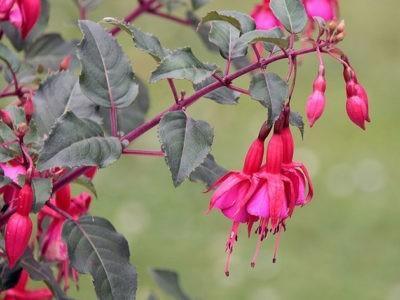

It is necessary to start applying dressings immediately after wintering and pruning in the spring and continue until autumn. You can buy special fertilizers in the storedesigned for flowering plants. But use them wisely.
If the flower is overfed, then it will grow lush foliage, and the flowering will be scarce. To prevent this from happening, fertilize no more than 1 time in 2 weeks. When choosing drugs, it is necessary that they contain the following components: potassium, phosphorus, magnesium, nitrogen (in low concentration).
In addition, there are the following rules that are recommended to be used when feeding fuchsia after pruning:
- Apply the nutrient composition only to moist soil.
- Dilute organic fertilizing with water 2 times more than indicated in the instructions. Otherwise, there will be no flowering, but the foliage will begin to grow rapidly.
- Do not feed the flower in winter.
You can find out about what proper care for fuchsia should be at home here.
Fuchsia wintering at home in an apartment
Often, in autumn, fuchsia continues to delight us with many flowers that have not yet blossomed buds, and a magnificent green mass of leaves. Everything seems to be fine, and I do not want to touch such a beautiful plant at all, let it continue to grow calmly. But, if you do not intervene, then the crown of the fuchsia will continue to grow very actively, but the flowers will be greatly crushed in the future, and the plant will not bloom so often. You need to know that in fuchsias, old wood does not bloom, flowers always appear only on new growths. If you take good care of the plant and trim it to last year's size, these standards can be successfully maintained for a very long time.
How to prepare fuchsia for winter? We do it right
Preparing fuchsia for winter should be started by trimming its crown. Do this in the fall, and shorten it to the level of 1/3 of its part. The old forks from the plant must be cut out without exception, which will allow the shoots replacing them to develop successfully. It is necessary to carry out pruning carefully so that the shape of the crown as a result turns out to be beautiful, moderately balanced. This can be achieved if several times, carefully, walk around the bush with a pruner. All thin branches are cut from the crown, which will allow the crown to acquire a more accurate structure in the future.
But, pruning must be carried out intelligently so as not to cut off too much, because then these branches cannot be attached back. When pruning, you need to achieve a crown volume of no more than a third of its original size. There will definitely be a leakage of juice when you remove the shoots, but this is quite natural. And so that the juice from the plant flows out as little as possible, first dry the earthen lump a little, and only then get down to pruning the fuchsia crown.
What to do after pruning the crown?
You have trimmed the crown of the fuchsia, now you need to remove all the foliage from the plant.This should be done with all the bushes that you continue to grow next year. After removing the foliage, fuchsia is treated with a fungicide and an insecticide, which will remove all parasites from the plant.
Pruning any plant cannot but affect it. Fuchsia, after this procedure, will definitely stop in its growth for some time, which, again, is quite normal. But, 10-14 days will pass (at a temperature slightly above + 10 degrees), and the plant will begin to grow quite actively again, which will allow it to recover to its standard size by spring.
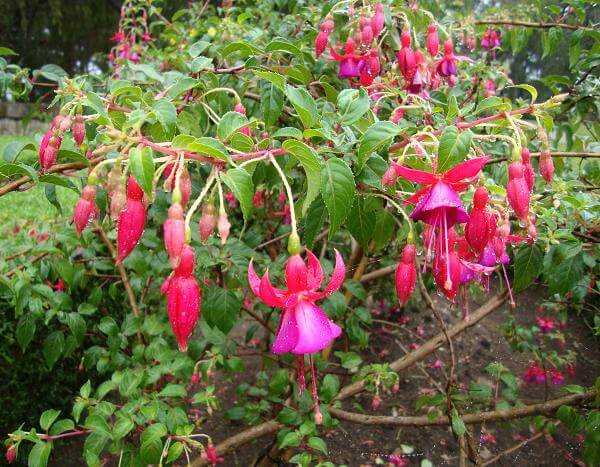

Winter is a resting period for many plants. Fuchsia, too, would be nice to have a rest at this time. For a good "rest", the temperature should be 2-3 degrees Celsius. It is believed that it will be easier for the juice to move, while maintaining the standard fuchsia until spring in a supine position. And, already in the spring, with an increase in temperature and degree of illumination, the plant can be taken out of storage.
Fuchsia care after wintering
For the further successful development of the plant, the potted soil in the spring will need to be slightly updated, or the plant will need to be completely transplanted, if necessary at the moment. The branches are irrigated with warm water for some time, which will soften the bark, and in addition, awaken young buds, and in general, this procedure will facilitate the further growing of the entire plant after wintering.
They pinch the shoots that have grown again. Do this twice, which will allow you to form the required size of the young crown. As a result, you should have a rather dense hat, moderately compact, with many flowers. The shoots will gradually grow, and so that the crown simply does not disintegrate, it can be fastened mechanically, if it is not possible to keep its shape in another way.
But in this video they will tell you about the wintering of fuchsias in the garden, in the open field. Take a look.
P.S. Was the article helpful to you? Please share it with your friends on social networks. I would be very grateful to you.
Did you like the article? Share with your friends!
Diseases
The plant is very rarely sick. Diseases can occur as a result of improper care, after pruning... The most common are:
- Rust... You can recognize the ailment by the presence of brown spots on the inner surface of the leaf. The disease is fungal and can be introduced by pruning if the tools used for the affected flower are not disinfected. it is urgent to remove the affected leaves, treat with Bordeaux liquid at intervals of 2-3 days.
- Root rot... This disease is formed as a result of improper moisture. In a healthy plant, the roots are white and elastic. If, during transplantation, it turned out that the roots are dark brown in color, then this is root rot.
Fuchsia pruning is a necessary agricultural technique, without which the plant will not actively and luxuriantly bloom. This process is simple, so even a novice florist can do it. But if this is not done, then the plant will take on an ugly shape, the number of buds will decrease, as will their size.
If you find an error, please select a piece of text and press Ctrl + Enter.
Fuchsia ("ballerina") is quite popular among summer residents and gardeners. However, many are mistaken, considering it an exclusively indoor plant. In natural conditions, shrubs can reach heights of more than 1m, and they require proper care.
Diseases and treatment of fuchsia
First of all, it is necessary to study the first signs of damage to the roots and leaves of the plant. Most of these problems are caused by improper flower care. Signs of root and leaf disease appear in the shortest possible time, therefore it is important to notice them in time, then it will be possible to save fuchsia from death.
The roots of the plant can tell a lot about the correct care. In a healthy flower, they are white and fairly firm.But if their color has changed to brown, and the structure has become soft, this is the first sign of the appearance of root rot.
Important!
Root rot occurs only in cases of excessive watering, and in these cases even the drainage layer will not save.
You can only help the plant by removing it from the pot, rinsing the roots and cutting off the brown formations. Then the flower should be placed in a container with clean water and left alone for several days. During this time, the plant will give new healthy roots, then it will be ready to be transplanted into a new pot with clean soil and fresh drainage.
Another reason for the slow growth of the plant is the small capacity. Determining whether a pot is small is quite simple - for this you need to remove a flower from it and examine its root system. If the roots wrap around the whole soil and turn it into a lump, you should purchase a spacious "housing" for the plant. And as soon as fuchsia is in it, its growth will resume again.
The leaves of the flower will tell a lot about the flower's poor health. Often the cause of the disease is a lack of nutrients in the soil.
Important!
The cause of many fuchsia diseases can be pests that actively harm it in the summer.
Typically, insect pests enter living quarters through open windows.
How to form a plant correctly
The plant is distinguished by flowers of an interesting shape, combining several shades. On each branch, several thinner stems are formed, on each of which 3-10 inflorescences subsequently develop. The flowers have an outer row of strongly opening pointed petals, several rows of small rounded petals and long stamens at the core. Each of these parts may differ from others in color, be blue, yellow, white, pink, red or purple.
Note! There is no single requirement on how to form a fuchsia bush correctly. The crown can have any shape, depending on your own wishes.
Pruning is necessary to remove the weakest shoots that will bloom poorly. For example, you can immediately remove too long and thin stems or those with only a couple of small leaves, while the rest are distinguished by an abundance of greenery. You also need to cut off the stems that have become stiff over time. Only the trunk of the bush cannot be cut off.
Planting fuchsia
Never put fuchsia in a pot with a lot of volume right away. It should be commensurate with the root system.
The pots are preferably made of plastic, with large drainage holes. Can be taken from unglazed clay, but only in light colors. In hot weather, black containers overheat, and the roots can "cook".
Transfer
Fuchsia is relocated to new soil in early spring. It is better to take a substrate consisting of mixed soil, peat crumb, washed sand and humus in equal proportions.Provide drainage in advance, you can use expanded clay. Pour a third of the prepared soil onto the drainage and place the plant on top, without getting rid of the old earthen coma. Fill the empty areas with the remaining substrate.
Place the newly transplanted flower on a light windowsill, trim the stems by one-third, spray and water. Subject to the transplant technology, fuchsia will bloom with many large flowers.
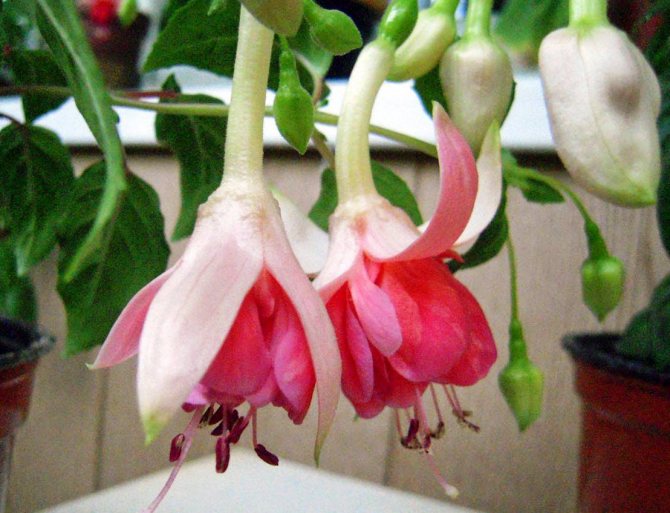

Fuchsia has faded: what to do next
What to do with fuchsia after flowering? It is necessary to partially cut the stems, this will have a beneficial effect on subsequent flowering. It is best to prune twice: in early fall and mid-spring. First of all, wilted or shriveled stems are removed. After that, you should cut off young shoots and twigs at the ends. Further, fuchsia is cut based on decorative preferences, that is, the desired crown shape is set.
Note! Fuchsia can easily wind around the support. It is often braided so that the stems grow in the right direction.You can twist young stems together so that they form one low trunk of an interesting shape.
When pruning fuchsia in the fall, it is important to inspect the branches for harmful insects or diseases affecting the bark. If something similar is actually found, the diseased branch and a small healthy part of it will have to be removed.
Whitefly control methods on fuchsia
In the summer heat, the windows of almost all apartments remain open, so the whitefly enters the living room. The whitefly is a very small butterfly that is difficult to see with the naked eye. She only needs a couple of hours - and the whitefly on fuchsia will lay its very small testicles. It is almost impossible to notice them, but the reaction of the flower is lightning fast. White midges appeared on fuchsia, what should I do?
The leaves of the plant begin to become covered with small sticky droplets, the number of which increases daily, even if they are constantly removed. As soon as the first larvae begin to appear from the eggs, they immediately suck the juice from the leaves, which leads to their rapid wilt and death.
At the first manifestation of the whitefly, the plant must be thoroughly rinsed with running water and laundry soap. Especially carefully you need to wash the stem and the inside of the fuchsia leaves.
Important!
When washing a plant using laundry soap, it is better to cover its roots with plastic wrap, since they categorically do not tolerate soapy water.
After water procedures, the leaves and trunk of the plant are treated with chemicals, Angara is best suited.
Fuchsia, worse than all indoor flowers, resists the attack of white midges. It will not be saved by ordinary folk remedies that are used to treat other flowers. In the case of fuchsia, only chemical agents will help, and even in tandem with a soapy bath.
After completely getting rid of the pest, the plant must be transplanted into a new ceramic pot with fresh soil. And only then can one begin the necessary work to restore the vitality of the flower.
How to form fuchsia on a trunk: pruning scheme, recommendations
What to do next when fuchsia has faded? After the fuchsia has faded, the faded cuttings and twigs that have formed above the young buds are removed.
The stem is formed from a healthy cutting with a strong, straight stem. When planting, a stick must be installed to support the main trunk. Next, you need to figure out how to form a planted fuchsia. To start forming fuchsia on a trunk, first it must be allowed to grow to the desired height, cutting off all lateral shoots. When the stem reaches the desired height, the top is cut off, immediately after that young lateral shoots begin to form. By pinching them, you can get a lush blooming bush.
Fuchsia - a medicinal plant
As a true medicinal plant, fuchsia, of course, is not used. However, the opinion of its magical, improving the aura in the house, healing properties is firmly among the people. Fuchsia is credited with a number of positive qualities.
Fuchsia magical properties:
- development of intuition, creativity;
- increased mental and physical activity;
- reducing the risk of exacerbation of chronic and acute forms of various diseases (gallbladder, gastrointestinal tract).
The existing legend gives the plant a particularly mysterious flair and fabulousness. Legend says that fuchsia flowers are nothing more than seven beautiful sisters who fell asleep forever in a whirlwind of fast dance. Witchcraft ruined the dancers for not wanting to be in captivity, but now collectors of the most beautiful flower can always admire this dance.
Poor fuchsia suddenly received another, not very pleasant name "widow's tears".
The existing belief says that the plant "survives" men from the house, but despite this, thousands of happy families are watching the extraordinary flowering of a wonderful bush.
Pinching and shaping a fuchsia stalk
You should not pinch the plant too often, at least you should be careful with this before flowering. Pinching consists in cutting off young shoots and leaves. The tips of very thin twigs, which have recently formed, are cut off, so the strength of the tree does not go to the growth of greenery that is useless in this season, but to make the flowers large and bloom well. Thanks to the pinching, the growth of the crown slows down; throughout the summer, it should be carried out about once every two weeks. Already in the fall, you can make a full pruning of the crown, while not reducing the number of flowers on the bush. Fuchsia, pruning and pinching of which is carried out correctly, will bloom much more abundantly, more magnificently and a little longer in time.
Note! You need to know how to pinch fuchsia so that it produces as many flowers as possible. The main shoot needs to be cut at an angle, soon two more young ones will appear from it, do the same with them.
A properly cut bush is overgrown with many young shoots, at the end of each of which inflorescences are formed. Basically, it is on young shoots that buds are formed, that is, in order to get a profusely flowering bush, it is necessary to cut off the maximum number of stems from which new ones will appear
Pinching and shaping a fuchsia stalk
Fuchsias in the spring: pruning, transplanting, pinching
Growing
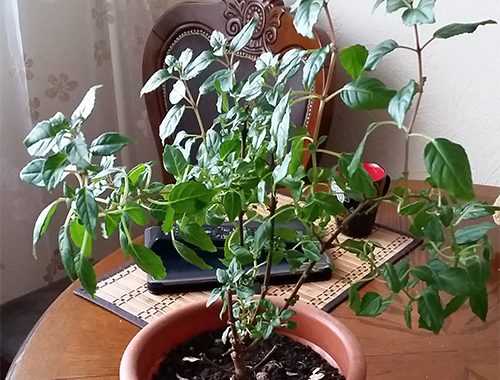

Fuchsias that have hibernated in an apartment are usually pulled out over the winter due to lack of light and excessive central heating. Daylight hours increase after the winter solstice, which means that things have gone towards spring. In January-February, pruning fuchsias helps rejuvenate the plant, form a beautiful crown and stimulate flowering. Cut off shoots can be rooted.
Related articles and video tutorials:
Video "Pruning Fuchsias in Spring"
How to properly trim fuchsia
Our customers often ask questions about preparing fuchsia for spring. Here are some examples:
Good day! Flowers lived in the country on the street. They took me to the apartment for the winter. They live on the windowsill. Can you please tell me if you need to crop?
Answer: Yes, it is advisable to cut the flower. The scheme for cropping your fuchsia in the photo above. Pruning stimulates new lateral shoots from the buds below the pruning line. The plant will be more branched, and on new strong shoots in the spring, you can expect abundant flowering.
My fuchsia has grown long shoots over the winter. What is the best way to cut it?
Answer: Schematically, trimming can be done as shown above.
I took 5 plants from you in April. I drove everything, everyone grows, thanks. It's time to get ready for spring. Advise how to trim?
Answer: Due to the lack of light, the plant is very elongated. Leave 2-3 internodes at the bottom to the trim line, carefully cut the rest.
What else is important to do in the spring?
Fuchsia transplant in spring
In the spring, it is advisable to transplant the fuchsia into fresh soil. To do this, remove the root ball from the pot. Gently shake off the old soil on the sides. Then place the root ball in the pot and add new soil to the sides, compacting it a little. Do not rush to enlarge the fuchsia pot. This may only be necessary if the root system is large and tightly wrapped around the existing pot. Otherwise, keep the same pot size.
Pinching fuchsias in spring
For good branching, each fuchsia shoot needs to be pinched. For regrown shoots, pruning is pinching, and we will pinch new shoots without waiting for strong regrowth. The sense of pinching is to stimulate branching of the shoot; for this, the growth point on each shoot is removed after 1-2 pairs of leaves.
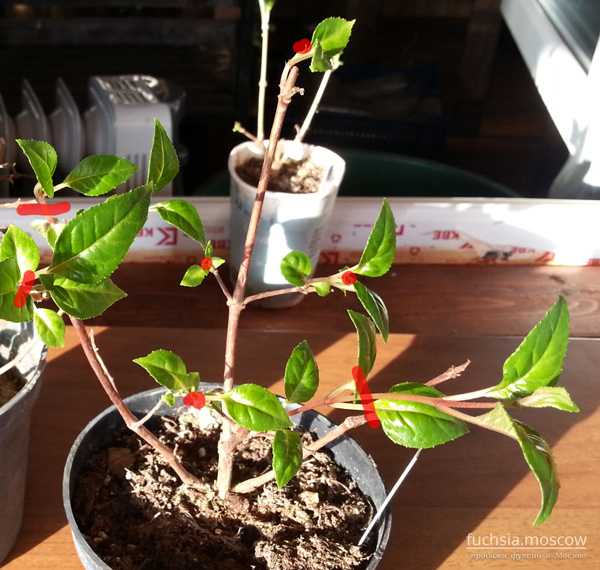

Top dressing of fuchsias in spring
After pinching and pruning, fuchsia should be fed with nitrogen fertilizer for active growth of green mass once a week. However, if the plant has been transplanted, set aside fertilization for 2-3 weeks.
Still have questions? Ask them here in the comments!
Related articles and video tutorials:
www.fuchsia.moscow
- When to plant carrots for the winter in Ukraine - Planting carrots before winter - planting dates, varieties of carrots
- What are potash fertilizers for? - Potash fertilizers - what it is, their names, meaning and application
- When to plant onions for the winter - varieties, timing and planting technology
- Growing onions exible through seedlings - growing through seedlings, when and how to plant, video
- When to prune trees in the garden - pruning timing in spring and fall
- Complex fertilizer - Complex fertilizers
Wintering fuchsia in the open field. Pruning rules for the winter
In most cases, gardeners are advised to dig up fuchsia for the winter and leave it in pots indoors or at home, since this is not so difficult to do. So it will be possible to protect the tree from frost, keeping it warm. If the bushes have already reached rather large sizes or there are a lot of them on the site, they will not be able to be stored indoors. In this case, you can simply cover the plants with spruce branches, spunbond. They should spend the winter well. Some varieties need to be cut almost below ground level, covered abundantly on top, sometimes even sprinkled with earth by 10-15 cm. At the end of spring, the plants are dug up, after which they begin to grow again.
note! Annual varieties of fuchsia can not be left for wintering, instead, cuttings will have to be rooted again every year.
Can you keep fuchsia in the house?
All types are used for landscaping housing, but most often compact ones are planted: Bolivian, three-leafed and recumbent. For its cultivation, a place is set aside on the north-west or north-east side of the apartment.
To create harmonious, warm relationships in the family, fuchsia is given a place where the household most often likes to be. This can be either a living room or a kitchen. The flower does not like bright sunlight; even indoor spaces are suitable for it, if there is additional artificial lighting there. Watering is frequent, but without stagnant water.
At the end of flowering, fruits of a round shape, sweet, with a slight astringency of taste are formed on the flower. It is customary to use them for the preparation of fillings for pies, alcoholic beverages, cooking jams and confitures.
Garden, vegetable garden and flower garden tips
Planting pepper in January 2020 lunar calendar
Sowing pepper seeds for seedlings in 2020 auspicious days
How to prepare viburnum for the winter at home recipe
If you want something exotic, you can try making ice cream topping. For him, wipe fuchsia fruits with mulberries and add powdered sugar, then lay them on ice cream balls and serve them to the table.
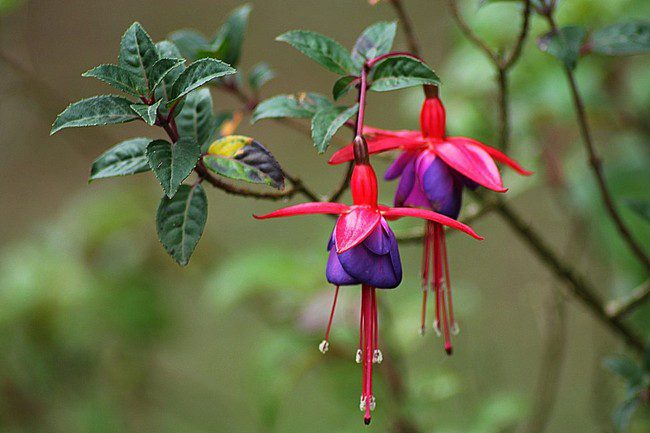

Useful tips for gardeners on pruning and shaping a fuchsia bush
Many are interested in how to cut fuchsia at home and whether it should be done at all. Pruning fuchsia at home should be done less frequently than when grown outdoors. A significant difference will be the size of the bush and the thickness of the stems. If in natural garden conditions a bush-shaped tree with a height of 1.5 m can turn out, then at home a small bush will grow no more than 20-30 cm.
Important! We need to figure out how to cut off such a small fuchsia so as not to cut off the extra stems. The pruning scheme is the same as on large bushes, young shoots are cut by 1-2 cm so that several new ones grow in their place.
Growing fuchsia at home is a little easier due to the lack of the need to transplant for the winter, and the temperature regime will not change so much throughout the year. And in summer, the scorching sun will not fall on the flower, whose rays often burn through the delicate leaves of fuchsia growing in its natural environment.
Plants that have miniature shapes and small size of leaves, and the flowers themselves, require much less strength and can bloom much earlier than other varieties. They require less careful maintenance and will bloom even in not the hottest climates.
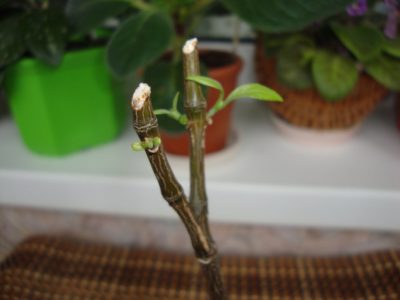

Fuchsia is a wonderful houseplant with lush flowers. The main difference is the bright and unusual flowering. In order to get a lush flowering, fuchsia must be properly pruned.
This procedure is carried out very carefully, observing all the recommendations and rules. Let's talk about all this in detail in our article. You can also watch a useful video on this topic.
Fuchsia in autumn. Pruning and preparing for wintering
Wintering 2 comments
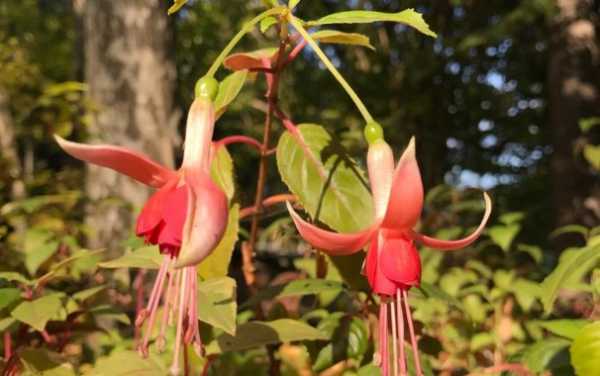

In autumn, when fuchsia is still green with a mass of flowers and buds, there is a temptation to leave everything as it is. However, with this approach, the crown will continue to grow, the flowers will become small and flowering is rare. It must be remembered that flowers are formed on a new growth, and not on old faded shoots. With good care and fuchsia pruning, the plant will bloom even more abundantly next year.
Pruning fuchsia for the winter
In the fall, the fuchsia crown should be cut in half or even more. Cutting out all the old forks
to enable new young shoots to form. You will have to repeatedly walk around the bush with the pruner to create a well-balanced shape, removing any thin branches, suggesting good structure in the future.
It is normal for sap to leak when removing shoots.
To minimize it, it is recommended to dry the earthen lump a little before cutting. When the fuchsia is trimmed, all the leaves must be removed. This applies to any shrubs that you send for cold wintering.
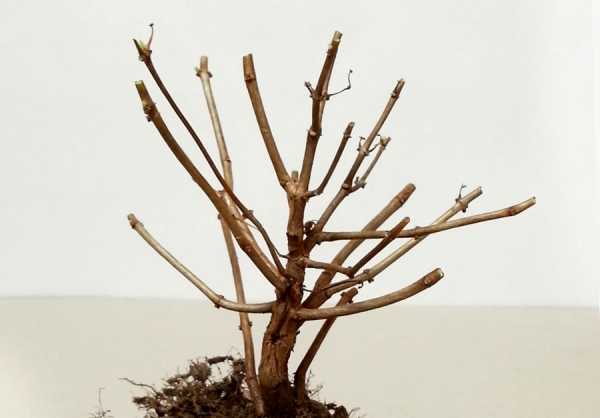

fuchsia pruning
Fuchsia pests
After removing the leaves, fuchsia must be treated with an insecticide and fungicide. This will protect the plant from parasites and possible rot. If you put a pot with a plant in a large bag, spray the preparation and tie it, then the effectiveness of the preparation will be much better. After pruning, the growth of fuchsia is delayed for a while, this is normal.
Fuchsia in winter at home
Like many plants in winter, fuchsia goes through a dormant period. Short daylight hours and lack of sun is a signal to reduce all active processes.
If you actively supplement the illumination of fuchsia on the windowsill in winter, then it will continue to grow after pruning. Otherwise, during the dormant period, it will simply stop growing and the main thing here is not to pour and dry. Watering should be sparse and sparse, but constant.
In spring, with an increase in temperature and lighting, fuchsia wakes up from hibernation. It is good to slightly renew the soil, and possibly completely transplant it into new soil.
Sprinkle branches for some time with warm water. This softens the bark, awakens new buds, and facilitates the further cultivation of fuchsia. Pinch the newly growing shoots to get the required size, while forming a dense, compact cap, which will have many flowers.
www.fuchsia.moscow
How to do pruning correctly?
Season selection
First, it is worth deciding when is the best time to prune the plant. It is often done in the spring. Pruning is done before new buds appear. If you do everything right, then the florist will get a beautiful and long-lasting flowering.
Is it possible in the fall?
Pruning Fuchsia in the fall is allowed, but this should be done in late October or early November. This option is suitable for growers who grow a flower as a houseplant. You need to trim in the fall in a gentle mode. On each of the branches, the parts on which the peduncles were are removed. Cut off the branches to the first pair of stone buds from the top.
Is it allowed for the winter?
Winter pruning is done for fuchsias that bloom until late autumn.
Pruning must be done before wintering (for details on how to properly prepare fuchsia for wintering and keep it in the basement and in the cellar, read here). It must be strong, leaving shoots only 15 centimeters long.If the crown is already formed, then it is worth removing weak shoots, and then thinning and shortening the remaining branches to one third of their height.
Pruning fuchsias in spring. Video and photo cropping lesson
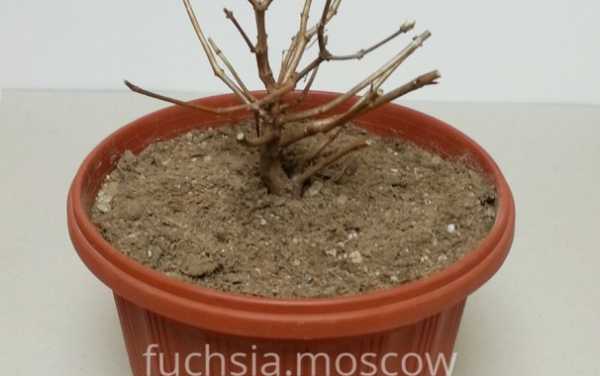

The end of winter is the time to start transplanting and pruning adult fuchsias. During the winter, plants stretch out and need our attention. We transplant the fuchsia into fresh soil, trim the crown and prepare the plant for the new season.
Related articles and video tutorials:
So, here are the fuchsias that spent the winter in my cold dark room in a wooden house.
Since the fall, I have shortened their shoots a little. Due to the low temperature, these fuchsias shed their foliage for the winter. This is normal.
Pruning fuchsias in spring
In February-March, fuchsias start growing. If you do not cut the old branches, then by summer their length will increase by about 30-40 cm. The crown of the plant will represent shapeless long lashes with flowers at the ends. Pruning fuchsias correctly will help shape the plant's shape.
There are several recommendations in this regard. It is usually advised to prune branches 1 / 3-1 / 2 of their length. You can also be guided by another rule: leave 2-3 nodes with buds on each branch.
Cut off the branches, leaving 2-3 buds
Fuchsia soil
I prepared fresh ground. Mixed peat, forest soil, sand and ash. These components have already been protected from pests and diseases by complete freezing. Additionally, I disinfected the soil over boiling water for an hour. Of course, such tricks can be avoided. Stores sell ready-made potting mixes for flowering plants.
Fuchsia pot
We take out the plant from the old pot. Lightly shake off the soil from the roots. If the roots are tightly braided over its entire volume, then we take the pot a little larger in diameter. If there is a lot of soil untapped by the roots in the pot, then it is better to plant the fuchsia in a slightly smaller pot. If the fuchsia is comfortable in the same pot, you can leave it in it. I pour a little expanded clay on the bottom of the pot, then soil and place the plant. I also fill the pot with soil on the sides.
Fuchsia after pruning and transplanting
New shoots
I spray the plant with a stimulant to awaken the buds and send it to the greenhouse. You can cover the pot with a transparent bag and put it in a bright, warm place. Now you need to be very careful with watering. Lightly moisten the crown and soil with a spray bottle. That's enough for now. Ventilate the greenhouse from time to time. It can be removed after one to two weeks.
As soon as new green shoots appear, they will need to be pinched. This will allow the plant to branch out and bloom more profusely.
Trim fuchsia video
Now fuchsias are ready for the new season and are sure to delight you with wonderful flowering!
Related articles and video tutorials:
www.fuchsia.moscow
How to achieve lush bloom?
Lush bloom is directly dependent on pruning. The later you do this, the later the plant will bloom. The procedure is performed 2 times a year. The first time before winter, and the second time in early spring. Spring pruning occurs in late February or early March. Its main task is to form a beautiful crown with many young shoots, at the ends of which buds appear.
Pruning features:
- To begin with, all fragile small branches are removed, since there will be no flowering on them or it will be weak.
- Then you can start removing dry and very thin branches.
- To prevent excessive bush density, you need to cut off the shoots directed to the center.
- When pruning shoots, it must be borne in mind that the crown must be of the correct shape. The cut is made at a distance of 1-2 centimeters from the knot.
Fertilizers for fuchsia
The correct selection of elements in top dressing will protect the flower from disease, promote good growth and improved flowering.
It is necessary to choose a top dressing based on the growth phase of the plant.
Young specimens need fertilizer containing a large amount of nitrogen - this element will ensure the growth of shoots.Grown fuchsia loves fertilizers containing phosphorus and potassium.
Fertilization frequency should depend on the concentration of the fertilizer. The usual concentration is usually used for fertilization every 7-10 days, but if feeding is carried out with each watering, the solution should be made weaker, at least 3-4 times. It is better to alternate mineral fertilizers with organic ones.
How to properly care for a flower afterwards?
- Lighting. Fuchsia is good for diffused lighting, so after trimming it must be placed on a windowsill, the windows of which face north or east. With a lack of light, small and rare flowers will appear in the plant.
- Watering should be moderate. Care must be taken to ensure that the topsoil does not dry out.
We talked more about how to care for fuchsia at home and in the garden in this article.
How does fuchsia grow?
How fuchsia grows is a question that many novice flower growers ask themselves. And this point is really very important, because it depends on how to form fuchsia at home. There are several types of flower, depending on the direction of growth of the bush: ampelous. Very showy plants, suitable for growing on balconies and summer verandas. Since their stems are very long and flexible, they bend downward under the weight of their leaves and flowers. Hanging pots are needed to grow them; semi-ampelous. This type can be grown both as ampelous and as standing. It all depends on the desire of the grower. To get a straight bush, you just need to tie the main stems of the plant to a standing support; bush. Fuchsia shoots of this type stretch exclusively upward, even without additional support.
Important! Regardless of the type, it is imperative to pinch fuchsia in order to enable it to fully grow and develop.
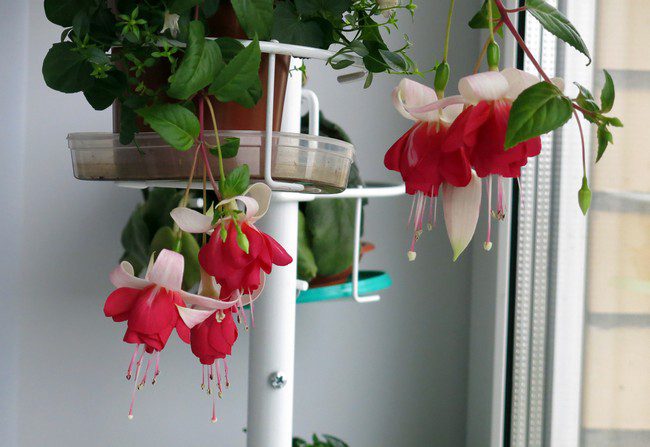

Fertilizers
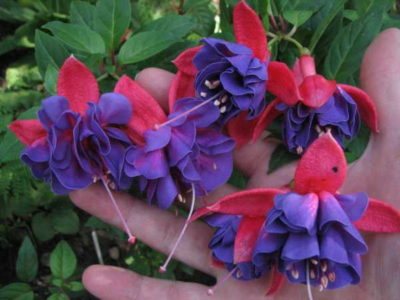

Top dressing begins immediately after wintering and spring pruning. You need to continue feeding until autumn. In specialty stores, you can buy fertilizers that are intended for flowering plants.
If you overfeed the fuchsia, then it will begin to grow foliage, but the flowering will be poor. To prevent this from happening, fertilizers are applied only once every couple of weeks. The composition of the preparations should include nitrogen, phosphorus, potassium and magnesium.
There are some the rules that must be followed when feeding a flower, after cutting it:
- Top dressing is done only in wet soil.
- Organic fertilizers need to be diluted with water twice as much as written in the instructions.
- During cold weather, the flower does not need feeding.
Fuchsia propagation
Basically, fuchsias are propagated vegetatively - by cuttings (and three-leafed - also by dividing the bush). This is usually done in early spring, in February - March, using last year's shoots from overwintered plants. Green cuttings 5-7 cm long are cut from the top of the shoots. The two lower leaves are removed, leaving the petioles, and the large leaves above are cut in half. For reproduction, you can also use pieces of stems without tops with 2-3 pairs of leaves, but they take longer to take root.
Prepared cuttings are planted in exploration boxes or bowls and kept at a temperature of 16-18 ° C. They can be pretreated with preparations-stimulants of root formation (according to the instructions). The substrate in the bowls should be light and breathable. They take root within 10-20 days.
In addition, cuttings of fuchsia quite easily give roots in water in a glass (preferably dark glass) container. Or you can root them in a special sponge, which is used to strengthen cut flowers in bouquets.
After the formation of roots, young plants are planted in pots (optimally - 7 cm in diameter) with any loose nutrient substrate. You can use a soil for growing seedlings made from high-moor peat with the addition of perlite and fertilizers. After planting, they are kept at a temperature of 15-16 ° C.Plants need good lighting, but no direct sunlight, and ventilation without drafts. Water abundantly, but the soil should not be too wet. When the cuttings start to grow, they begin to feed them with nitrogen and potassium fertilizers. Then feeding is continued every 10-12 days using full complex fertilizer. You can alternate them with humic extracts (Agricola, potassium humate, Humate + 7 and others).
More recently, fuchsia hybrids have been obtained that can be propagated by seeds. They bloom 4-5 months after germination (that is, when sowing in January - already in July) and bloom until the first frost. Crops are kept at a temperature of 24 ° C and in the light, but still, shoots usually appear only after 45-55 days. The resulting seedlings dive into the substrate, the same as for cuttings, in pots with a diameter of 5 cm. Just like cuttings fuchsias, seedlings need a lot of light, good ventilation, watering and nutrition.
Cultivation, reproduction and transplantation
Taking care of Fuchsia at home is pretty simple. Even a novice gardener can grow this flower. You just need to remember some of the growing rules:
- Maintain the temperature around 20 degrees in the summer and bring it down to 5 degrees in the winter.
- In winter, fuchsia needs more light.
- In summer, the flower can be taken outside to breathe fresh air.
- Protect from drafts.
- Do moderate watering with soft water.
- Follow the recommendations for feeding and the choice of fertilizers.
- Make timely and correct pruning.
Fuchsia transplant is carried out every year. This renews the flower and gives space to the overgrown root system. The container is selected in medium size, made of ceramic and light in color. At the bottom of the pot, drainage must be present; expanded clay is well suited. The plant is not very demanding on the soil, but it is better to use a soil mixture of peat, sand and deciduous soil.
Reproduction occurs by seeds, cuttings and leaves:
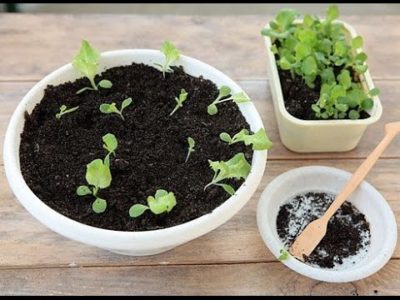

Fuchsia seeds are not often propagated, since it is difficult to get seeds, for this you will have to artificially pollinate the flower. Also, the seed method will not allow you to get a plant with exact varietal characteristics.- Most often, cuttings are used for propagation. This method is the simplest and most popular.
- And the third type of reproduction is by a leaf. Fast and easy way. You will need to tear off the largest and healthiest leaf, put it in a loose substrate and cover it with a jar on top. After the formation of processes, immediately transplant into a pot.
Read more about how to plant fuchsia at home here, and from this article you will learn about the features of growing and caring for this beautiful flower in the garden.
Fuchsia indoor: care, pruning, breeding methods and winter rest
Fuchsia is an exotic South American plant that delights the eye with its variegated flowers from April to mid-fall. She attracts attention with grace and variety of color palette. Legends and poems are written about this beauty. Interesting signs and superstitions about fuchsia are known.
In its natural environment, the culture grows in the form of a shrub that has elastic stems. The leaf plate is green with a slight burgundy tint. It is oval, opposite and with sharp cut edges. It blooms inordinately generously and for a long time with fascinating flowers.
Hybrid fuchsias that grow on windowsills and in the garden are distinguished by a variety of shapes and palette. This is what interested lovers of picturesque flowers on the windowsills. Every year, new hybrids are released from breeding laboratories, satisfying the desires of even spoiled gardeners.
Home fuchsia care
Taking care of fuchsia, oddly enough, is not difficult. Keep in mind that this culture prefers shady places where it does not exceed 20 C in summer. However, the burning sun is not so scary for fuchsia as the high temperature.With it, the likelihood of destructive overheating of the roots increases significantly.If the apartment is too warm, it is recommended to move the fuchsia to the balcony or terrace. Find a calm, lighted place for it, where the sun will shine on it only in the morning.
Important! If you organize the proper conditions for wintering, you will get large and strong plants in the coming season.
In autumn, when fuchsia is still with flowers, it is very tempting to leave it blooming for the winter. But then the crown will continue to grow, the flowers will become small, and the flowering will be rare. So remove all flowers and prune.
In winter, fuchsia hibernates. The main thing is to find a cold place for her with a temperature of 5 to 15C. In winter, lighting for fuchsia does not matter. Two or three times a month, the flower should be watered - the dried up soil, even during dormancy, will not be to the flower's liking. Do not worry if the plant throws off its leaves - in the new season it will grow new, young ones.
In the warmth, fuchsia will also overwinter, but it can hit its growth, and in the spring it will need to be trimmed.
Watering and lighting for fuchsia
Water the fuchsia in moderation, without "extremes." The soil should be kept moist during flowering. Wait until the topsoil is dry before watering and only then can it be moistened again.
It is vitally important for her not to allow water to stagnate in the soil, which can cause the roots to rot. Use separated filtered water. In late autumn, reduce the supply of moisture to 2-3 times a month, and in winter - generally to 1-2.
Spraying will bring a lot of freshness to the beauty of fuchsia. Do this only in the summer. If you put the plant on a pallet moistened with expanded clay, it will help to increase the humidity, which will certainly please him.
Choose a stable permanent place for the flower initially; it is undesirable to transport fuchsia during flowering. Such a shock will provoke shedding of flowers.
Avoid the midday sun, it should only illuminate the plant in the morning. If this is not possible, adjust the lighting with blinds.
Fertilizer for fuchsia
Indoor fuchsia responds well to feeding. They do this every ten to fourteen days, and only in the flowering phase. When buying or preparing fertilizer, make sure that there is no nitrogen in it or its content is very low.
Liquid fertilizers are applied only to wet soil. Top dressing will help the fuchsia grow in green mass and form more buds. It is allowed to apply foliar dressing, but only on the inside of the leaf.
Young, freshly bought seedlings from garden centers do not feed, they are initially planted in prepared soil with the addition of all the necessary microelements.
Planting fuchsia
Never put fuchsia in a pot with a lot of volume right away. It should be commensurate with the root system.
The pots are preferably made of plastic, with large drainage holes. Can be taken from unglazed clay, but only in light colors. In hot weather, black containers overheat, and the roots can "cook".
Transfer
Fuchsia is relocated to new soil in early spring. It is better to take a substrate consisting of mixed soil, peat crumb, washed sand and humus in equal proportions.Provide drainage in advance, you can use expanded clay. Pour a third of the prepared soil onto the drainage and place the plant on top, without getting rid of the old earthen coma. Fill the empty areas with the remaining substrate.
Place the newly transplanted flower on a light windowsill, trim the stems by one-third, spray and water. Subject to the transplant technology, fuchsia will bloom with many large flowers.
Fuchsia pruning
Since fuchsia flowers arise on young shoots, the more of them there are, the more magnificent the flowering. For this, circumcision is carried out, and pinching for young shoots.Pinching is a fairly effective method for making fuchsia grow more buds.
Gardeners advise pruning homemade fuchsia twice: after flowering in early October and early January.For the first time, cut off all faded cuttings 2 cm from the dormant buds. After that, get rid of the seed bolls and peduncles. During the second pruning, shape the crown as you see it.
Seed propagation
If you propagate fuchsia by seed, you will have the opportunity to feel like a breeder and get your own plant variety. As you know, the samples obtained from seeds lose the characteristics of the parent plant and acquire their own.
First, eliminate any pollination. Cut off the stamen of the still closed flower, pollinate the pistil with the pollen of the parent plant and put a cotton or paper cape on the flower to protect it from insect interference. Carefully open the swollen ripe fruit, remove the seeds and dry them.
Important! Do not shake the seeds during ripening, so as not to overshadow the results of your labors!
The resulting seeds are placed in wet soil and sent to the greenhouse. After ten days, it will be possible to observe the first sprouts, after one and a half to two months it is necessary to dive, and after two more, the strengthened seedlings are placed in their pots.
Propagation by cuttings
This is the most natural and reliable method to propagate a culture and can be done all year round. However, it is more correct, nevertheless, to carry it out in the spring. Take only young cuttings, as woody cuttings will take much longer to root.
Take a 10-20 cm long stalk and remove the lower leaves. Place it in water that has stood for several days before, and wait for the roots to appear. To create greenhouse conditions, cover with a plastic bag or bottle. Roots will be nailed on the fifth day. There is no need to wait for large roots, plant the finished seedling in a prepared pot with a substrate. Some daredevil growers plant cuttings of the plant directly into the ground, skipping the rooting stage. But they also do not refuse from an impromptu greenhouse.
In the fall, the plant prepares for the hibernation period. Life is slowing down, so from September to January it is not worth propagating the culture.
Reproduction using leaves
If it turns out that there is no suitable petiole for cutting, use fuchsia leaves. Separate the strong, largest leaf together with the stem and deepen it a centimeter into wet perlite. Create the same greenhouse conditions and spray every day. A week later, a tiny rosette of leaves will form at the base. After it grows up and hardened, cut it off and plant it in a pot of nutritious soil.
Winter rest
For healthy leaf formation and rich flowering, every plant needs proper rest to replenish its vitality.
When preparing the crop for rest, reduce watering, stop fertilizing and, over time, move the fuchsia pot to a chilled room, where it will winter.
Diseases of fuchsia room
Indoor fuchsia occasionally gets sick. However, if the humidity is high, powdery mildew may appear or the roots will begin to rot. When the substrate dries up, leaves and flowers will fall off. Protect the plant from drafts, they can also provoke shedding of buds.
Pests
Pests live in fuchsia bushes in very arid conditions. The most common parasites for this species are whitefly and spider mites. Whitefly can be seen with the naked eye, a lot of tiny midges scatter if the plant is slightly edged. It leaves its larvae and eggs on the leaves, which reproduce quickly, and it is very difficult to fight them. The presence of a spider mite is determined by the cobweb formed between the leaves.
How to deal with pests
If you identify such problems on your beauty, immediately resort to folk methods or chemical insecticides, since it is not a problem to buy them today.
It is necessary to spray diseased plants several times with the preparations "Lepidocide", "Bitoxibacillin", "Bicol", "Fufanon", etc., at intervals of 5 - 7 days, until complete salvation from parasites.
If you grow fuchsia with love, you will receive its gratitude in the form of continuous generous flowering. It will help create a bright aura in your home and cleanse it of negativity.
Diseases
Fuchsia rarely gets sick, most often this is due to improper care after pruning. The most common ailments:
- Rust. Brown spots on the inside of the leaf are a clear sign of this disease. It could get on the plant due to poor disinfection of instruments. To get rid of the disease, you urgently need to remove the infected leaves and treat with Bordeaux liquid at intervals of 2-3 days.
- Root rot. Appears as a result of excessive moisture. If dark brown roots were noticed during transplantation, this means that the flower has rotted. Such fuchsia can no longer be saved, the only thing that can be done is to cut the cuttings and root them.
- Chlorosis. A flower can get sick with chlorosis if it is watered with tap water. The main symptom is yellowed leaves. To return a healthy look, you need to revise the watering regime.
The causes of pests and diseases of fuchsia
The main reason for the appearance of pests and diseases is improper plant care. If the florist devotes enough time to his pet, you can forget about problems with him. If the focus of infection was noticed and removed at the time, the flower is able to restore its vitality on its own.
In case of serious problems, the primary task will be to find out the reasons and make a "diagnosis", only in this case all the measures taken to get rid of the infection will be quite effective.
All fuchsia diseases can be divided into two types:
- diseases due to inadequate or improper care;
- fungal or pest infestation.
Features of the procedure: instrument, disinfection
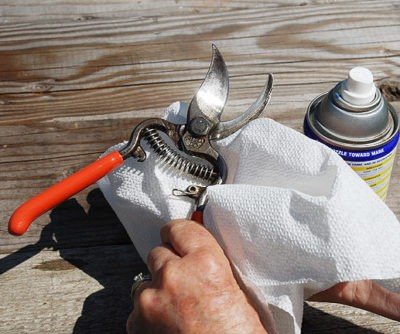

The main tool is a garden knife or scissors. Very necessary, disinfect the equipment before the procedure. This will prevent viral diseases that are transmitted with the sap of the affected flowers. Various compositions containing alcohol are used for disinfection.
You can use medical sprays, alcohol wipes, or household products such as chlorine and kerosene.
Well disinfects permanganate vitriol... Instruments are dipped into the solution for a few minutes, and then wiped with a clean cloth.
Lighting
Fuchsia is a photophilous plant, but it does not tolerate bright sunlight at noon.
Therefore, the optimal place for her is the windows facing east and west. The gentle morning and evening rays of the sun will be just in time.
If the flower is on the south window, shading is needed, for example, with a sheer curtain. On the windowsill on the north side, fuchsia will not disappear either, but it will be very stretched, the flowers will become small and pale, and their number will be significantly reduced.
For a flower, it is better to immediately determine its place. It is better not to rearrange fuchsia during flowering.because it can throw off buds and even leaves because of this. In warmer months, fuchsia can be taken out on the balcony or in the garden. However, it must be accustomed to new lighting gradually to avoid burns.
Pruning and pinching
The optimal amount of fuchsia trimmings is two per year. The first pruning is done when the plant has finished flowering. At this time, all peduncles, seed pods, as well as axillary branches, which have faded and are at a distance of several centimeters from the sleeping buds, are removed. Dried and broken shoots are also cut off.
The second pruning is winter, it is done when the fuchsia is sleeping. This pruning forms the crown of the plant and is also designed to remove excess shoots. Fuchsias are often grown using the bonsai technique; for this, during winter pruning, you need to leave one or more vertical shoots, which are usually twisted - they will be the trunk.
Fuchsia crown formation is done not only by pruning the shoots. Not the least role is played by the pinching of young shoots during the entire period of plant growth, but the main emphasis is on this in the spring.
Fuchsia, which wakes up after a winter rest, begins to grow actively, launching shoots from each bud. Too elongated need to be pinched so that the fuchsia crown is neat, "combed".
Usually the ends of the shoots are pinched over the two lower pairs of leaves. When new shoots develop from their sinuses, a pinch is done over the 3rd or 4th pair. Usually this is enough for the bush to turn out neat, giving abundant flowering.
Sometimes fuchsia is grown in standard form. The strongest cutting with a well-developed root system is selected for this. Pruning in this case is carried out according to the following rules: side shoots are removed so that the plant grows straight up. When it grows to the desired size, the crown is trimmed to allow the side branches to grow. As a rule, within three years, less often more, a beautiful tree covered with flowers is formed.
Using pruning, you can postpone the flowering time of fuchsia, for example, make fuchsia bloom in winter. This is achieved by pruning the plant in summer. Fuchsia must be kept until the beginning of summer in a dark and cool room, and then for three months every regular pruning so as not to give it the opportunity to form buds. In the fall, it will need to be left alone, and it will actively bloom.
Is it possible to cut fuchsia for the winter and how to carry out the procedure so that there is a lush bloom?
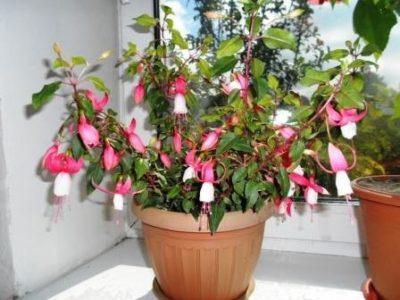

Fuchsia is a beautiful and lush houseplant. Differs in bright and original flowering. But for this you will have to take full care of him.
Pruning remains one of the main ways to create lush blooms. This is a rather responsible process, which involves adherence to certain rules.
From the article you will learn how to prune fuchsia for the winter, when it is best to do it and how, as well as how to deal with various diseases and pests.
Various crown shapes
By pruning, you can give fuchsia a shape that fits well into the design of a room or flower garden. If you need a shrub, cut off the top of a young cutting, leaving 2 pairs of lower buds. New shoots will soon appear from the sinuses, which will also begin to release buds. The tops of young shoots should be pinched. At the same time, look at the varietal characteristics of the plant. If internodes are located far from each other, leave 2 pairs of buds on the shoots, if close, then 3-4. Carry out this procedure on all new shoots until you decide that the crown density is sufficient.
The trunk can be given a sinuous or curved shape, such plants look spectacular and original. If you plant several fuchsias in one pot, you can intertwine or intertwine their trunks in various ways. It is necessary to carry out this procedure while the shoots are young and bend well. At first, the position of the trunk should be fixed with strong threads, and when the wood becomes solid, the ropes can be removed. An interesting composition will turn out if several varieties with inflorescences of different shapes and colors are grown in this way.
If you want plants of different heights to grow nearby, pinch their tops at the right level.
Correct pruning in the fall will help your fuchsia not lose strength over the winter, and in the spring it will release strong shoots that will give many flowers. You can limit yourself only to thinning and shortening the branches: this plant is beautiful in its natural form.If you want to give the flower an original shape, a haircut and pinching will give you a lot of room for imagination. The combination of ampelous, semi-ampelous and erect species will make it possible to compose a decorative composition that adorns both the flower garden and the interior of the apartment.
Why does fuchsia not bloom
What to do in such cases? Where to look for the reason? The reason most often lies in improper care. This may be excess moisture, in which the roots rot. In this case, you need to adjust the watering. Fuchsia will not give flowers even if it lacks light. Since she is painful to permutations, you need to initially take care of sufficient lighting. If the flower is located near the north window, you can only help here with additional light sources.
If the plant lacks trace elements, it will also respond with a lack of flowering. But it is necessary to remember that an excess of nitrogen also leads to this. Therefore, top dressing must be strictly balanced. During the winter, the temperature for fuchsia was not provided - it was too hot. In this case, you can help by carefully moving it to a room with a low temperature for several days.
Too large a pot is a common cause of lack of flowers. When the roots have an excess of space, they grow first, then the leaves. All the plant's strength is spent on this. There is only one way out - to transplant fuchsia into a tighter container.
Indoor fuchsia - description and origin
This very beautiful, brightly flowering houseplant belongs to the fireweed family. Its wild ancestors and relatives grow in the mountain forests of South and Central America, New Zealand, Tahiti and the Falkland Islands. She began to conquer Europe in the 17th century, when a spectacular garden culture was bred from a wild weed by the French botanist Charles Plumier.
Fuchsia in home growth is a low evergreen shrub that grows up to 80 centimeters. It cannot be confused with any other indoor plant, it has such unusual flowers. For their shape, they are often compared to Chinese lanterns. Delicate sepals and petals are painted in bright colors, and the flower itself surprises with its some kind of unreal beauty, as if it were not a creation of nature, but a fantastic idea of a needlewoman.
Modern indoor fuchsia has ampelous, bush or standard varieties. Its leaves are most often opposite, whorled less often, and even more rarely alternate. They have a lanceolate or ovoid shape, the edges are serrate, crenate, solid.
Flowers of graceful shape hang down on thin rather long pedicels. The calyx of the flower is tubular, above which four lobes are located horizontally or bent upwards. Often the calyx and lobes differ in color. The stamens and pistil, slender and long, protruding significantly outward, is the finishing touch.
Preparing an indoor flower for winter
The plant also needs rest. If you leave fuchsia in a hotly heated room, continue feeding and watering according to the summer regime, it will not gain strength and will not be able to bloom abundantly next year. When growing in an apartment, consider the area that the overgrown crown will take. If you leave too long shoots, in the summer they will begin to grow intensively and the bush will take up half the room.
Fuchsia pruning can be done in spring and autumn. If you were doing this work in the spring, before wintering, be sure to check how much the shoots have grown. In the first year, the bush should not enter a dormant state with long stems - cut them shortly, leaving about 15 cm each. When the crown is formed, remove all weak and diseased branches. The bush should not be too thick - leave only strong shoots, cut off the rest. Shorten all remaining processes by 1/3 of the length. The flower is now ready to hibernate.
When pruning, pay particular attention to semi-ample shapes. Weak shoots can break under the weight of the lush inflorescences. Leave only strong branches, and remove all thin ones.
In living quarters, it is undesirable to leave fuchsias for the winter. Plants need temperatures no higher than + 10⁰ C, and people in such conditions will feel very uncomfortable. The best place for flowers would be a cellar, basement or glazed loggia. If the temperature does not drop below zero, the plants will winter well. Not all owners have suitable buildings, sometimes you have to keep bushes in the apartment all year round. Choose the coldest corner for them, but even there the fuchsia will not be able to fall into a state of dormancy and will begin to release thin, weak shoots. Do not let new branches grow, be sure to cut or pinch them at the very beginning of development.
In the spring, cut off diseased fragments and shorten branches that have grown over the winter. When young shoots begin to develop, pinch the tops from time to time to make the crown more lush. With this procedure, keep in mind that it will take about 2 months from the last operation to flowering. So that in the summer the bush is already covered with lush inflorescences, finish the pinching no later than April.
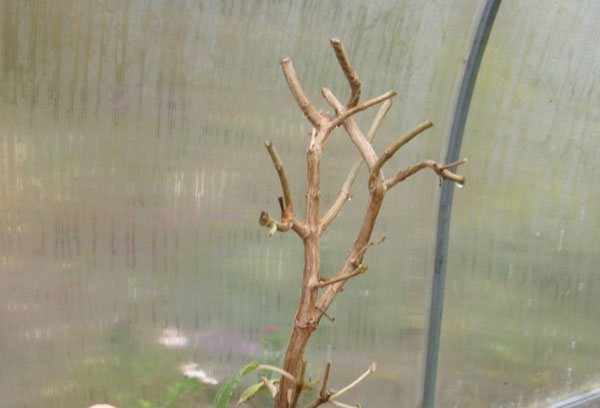

Seed propagation
If you propagate fuchsia by seed, you will have the opportunity to feel like a breeder and get your own plant variety. As you know, the samples obtained from seeds lose the characteristics of the parent plant and acquire their own.
First, eliminate any pollination. Cut off the stamen of the still closed flower, pollinate the pistil with the pollen of the parent plant and put a cotton or paper cape on the flower to protect it from insect interference. Carefully open the swollen ripe fruit, remove the seeds and dry them.
Important! Do not shake the seeds during ripening, so as not to overshadow the results of your labors!
The resulting seeds are placed in wet soil and sent to the greenhouse. After ten days, it will be possible to observe the first sprouts, after one and a half to two months it is necessary to dive, and after two more, the strengthened seedlings are placed in their pots.
How to prepare fuchsias for winter?
This flowering plant pleases with its bright flowers until late autumn. However, how to properly prepare it for winter?
Since the end of August, I have been using phosphorus-potassium fertilizer, completely excluding nitrogen and reducing the interval between fertilizing to 2 times a week (I give the shoots the opportunity to fully mature). My fuchsias grow outdoors all summer and winter in the cellar. For such wintering, the bush should have well-developed branches covered with bark. Green twigs in the basement will not overwinter.
I also slowly reduce watering. In October I feed for the last time phosphorus fertilizer and after that I remember about feeding only in the spring. Fuchsias growing in open ground should be dug up and transplanted into a pot; before wintering, the bushes will have time to take root well.
I do not forget to remove wilted flowers and yellowing leaves in time. I examine fuchsias for hidden pests. If "living creatures" appear, I immediately process all the plants with actellik. Usually one treatment is enough, moreover, actellic is effective against both ticks and insects.
If the night is expected a sharp drop in temperature, I transfer all the "beauty" to the house, and in the afternoon - back to the fresh air. I try to withstand fuchsias on the street for as long as possible, so practically without my intervention they prepare for winter.
End of october... Fuchsias look slightly "shabby", the foliage has almost all turned yellow and crumbled, flowering has practically stopped. I turn to the basic preparation of plants for moving to the winter storage. Be sure to remove any remaining foliage.
For the prevention of fungal diseases, I spill all the pots with a solution of Maxim or Fundazol. You can also spray fungicides on the ground part of the plant.After processing, I let the bushes dry and start cutting.
I cut out all weak, green shoots, shorten the tops by about 1/3.
Let the slices dry thoroughly in a warm, dry place. Transferring the pots to the cellar. The temperature there does not drop below 3-5 ° C, the humidity is high enough, so I do without winter watering.
Owners of a warm, dry basement should definitely watch out behind soil moisture in pots, otherwise fuchsias can turn into a "herbarium" by spring. If the wintering room is not very large, you need to shorten all the shoots by 1/3, cut out everything that interferes.
Shake the fuchsias out of the pots. Tightly, bush to bush, put in a plastic box from under the vegetables.
Cover the space between the walls of the box and the earthen lump with sphagnum moss or peat. Remember to give each bush an individual name tag. It is convenient for these purposes to cut aluminum cans from beer or drink into strips, squeeze out the names of the variety on the strips with a ballpoint pen and attach the tags to the fuchsia trunk with a wire.
Balcony
We also try to keep fuchsias on the balcony for as long as possible. With the onset of stable cold weather, in the presence of a warmed balcony, we keep fuchsias there. If the temperature on the balcony does not drop below 5 ° C and does not rise more than 10 ° C, such a wintering for fuchsias is simply wonderful. Plants stop active growth, but do not hibernate at all, they seem to be dormant.
With an increase in daylight hours, fuchsias will wake up and grow faster, in contrast to plants that have wintered in the basement. The care of the grower during this period is to maintain the soil moisture in the pots and monitor the ambient temperature. Processing and pruning for fuchsias wintering on the balcony is the same as when preparing for wintering in the basement.
Window sill
Slightly shorten the overgrown shoots and place the pots of fuchsias close to the glass. You can put foam or other insulation under the pots so that the root system does not suffer from the cold. If it is hot in the apartment in winter, you may have to separate the wintering fuchsias with plastic wrap, blocking the access of dry air and creating a kind of greenhouse on the windowsill. The condition of the plants must be monitored very carefully.
Adjust watering - fuchsias should not be poured, but drought should also be avoided. In the warmth, fuchsias will inevitably grow, pale thin shoots must be pinched. Fuchsias wintering on the windowsill must be supplemented.
Carefully monitor the pests. Control measures - compulsory spraying with suitable preparations. There is no need to feed the wintering fuchsias, keep the plants "on starvation rations" until spring.
Fuchsia pests and control measures
Since the flower of gypsy earrings is very vulnerable, it is necessary to inspect it regularly. The sooner a threat is noticed, the easier the treatment is. And one more important rule - when any pests or diseases appear, it is necessary to isolate the diseased plant from other indoor flowers.
This harmful insect is capable of infecting almost all parts of the plant - roots, stems and leaves, buds and opened flowers. In this case, the above-ground organs take on a distorted shape (curl), lose their characteristic color (most often turn yellow) and fall off. Where aphids have settled, a sticky liquid appears.
Aphids on fuchsia spread very quickly, so the fight against it must be started immediately. If the scale of the problem is not very large, then it is enough to rinse the bush in soapy water. If an insect attacked the entire plant as a whole and appeared on other indoor flowers, then professional insecticides should be used.
Read on r— kopilka.ru:
Whitefly
White midges that stick around all parts of the plant - this is the whitefly. She enters the house from the street through open vents and windows. The insect sucks the juices from the leaves, thereby slowly killing the plant.
It is impossible to remove this pest manually.The fight against whitefly on fuchsia begins with preliminary washing of the bush with soapy water. Especially carefully it is necessary to process the stems and the lower surface of the leaf blades. After that, the gypsy earrings are treated with an insecticide.
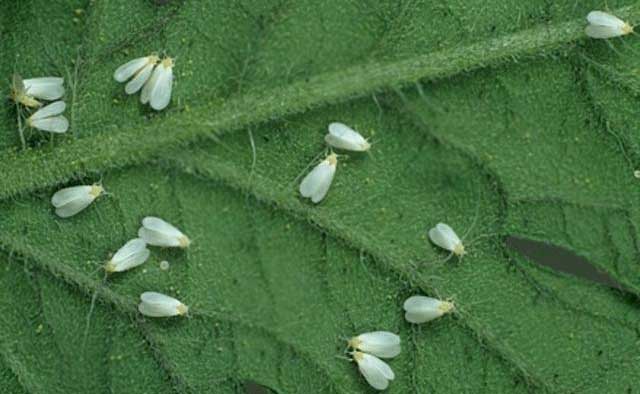

Nematodes
Different types of this pest affect the roots, stem bases, petioles, leaves and fuchsia flowers. On the roots, neoplasms develop - galls. Yellow spots appear between the veins on the leaf blades. Over time, these spots acquire a brown or brown tint. The bush is constantly losing leaves. When a root nematode is damaged, a thickening appears on the root collar, new shoots start growing at the base of the stem, and the whole plant withers.
If the affected bush is not transplanted into new soil and the gypsy earrings are not sprayed with special insecticidal agents, then leaf and root nematodes will multiply rapidly and the plant will die. In parallel, during treatment, watering is reduced and spraying is completely abandoned.
Disease and pests are a serious problem when growing indoor fuchsia. But if you adhere to competent care, then you can protect your beauty and provide her with a long healthy and prosperous life in the literal sense of the word.
Tropical ballerina fuchsia
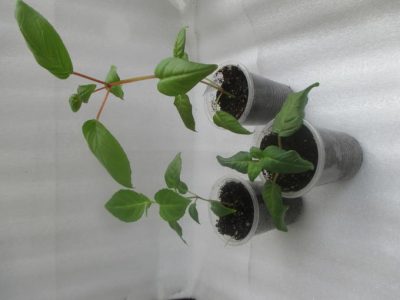

Fuchsia is an extraordinary plant, which is also often called a ballerina. The beauty of fuchsia, home care for which is quite simple, blooms profusely, grows quickly, has a charming decorative look. Diplomas, eustoma, bougainvillea are not inferior to her in beauty. This name for the flower coquette did not appear by chance. The buds of this plant resemble a small, graceful figure of a dancer with a skirt.
:
Many legends are associated with this unusually beautiful tropical representative. One says that 7 sisters once lived in this world. Rumor has spread about their beauty outside the state. When they danced together, nature seemed to freeze: the breeze stopped fluttering the foliage, the sun did not go down so low, the animals became meek.
Once the evil magician saw the sisters' magic dance and wished to take one of them as his wife, and make the rest his concubines. When the girls rejected the groom, he became angry and turned them into flowers of extraordinary beauty, reminiscent of dancers in bright dresses. Later, the plant was named fuchsia.
From lighting selection to transplanting
Fuchsia at home
A tropical ballerina needs proper grooming. A home decorative inhabitant needs not only watering, but also the observance of temperature and humidity conditions.
It is required to select the proper temperature regime; winter rest is needed for abundant flowering. In summer, during the growing season, it is recommended to keep the temperature at 20-25 ° C, at +30 it already begins to shed foliage. In hot weather, it is necessary to take the pot out to the balcony, creating protection from bright sunlight and ensuring spraying.
In winter, it is recommended to lower the temperature to + 8-10 ° C, so that the pet can rest and get ready for flowering. This is a prerequisite for grooming and should not be neglected.
This decorative creature prefers diffused lighting; the window sills of the western and eastern windows are considered the best place for growing. You can not touch a flowering plant, turn it in different directions to the sun, as it will immediately respond by dropping the buds.
Fuchsia, which is not so difficult to care for, prefers abundant watering in spring and summer, but as the topsoil dries out. In winter, the amount of water must be reduced, in October-November it should be watered at a time when the earthen lump has not yet completely dried out. This will allow the plant to enter a dormant state normally. At low temperatures, it is recommended to water once or twice a month.
During growth, it is necessary to spray the foliage from a spray bottle with warm water, you can put a small bowl next to the pot filled with pebbles and water.With the arrival of autumn and winter, spraying is stopped, the amount of moisture should be minimal.
In March, you can start feeding using fertilizers for flowering house plants. This should be done once every 10 days; with the arrival of winter, it is better to refuse feeding.
The gentle ballerina requires an annual transplant in the spring. You can take any fertile soil, adding loam to it, which perfectly retains moisture, plus humus and sand.
Return
What breeding rules should you follow?
Fuchsia propagation is possible in several ways:
- Using cuttings. It is better to start the grafting process in February-March, but it is also allowed in August-September. The second period is only suitable for slow growing varieties. The cuttings should be up to 7 cm long and must be rooted in a sandy environment or loose soil. On about the 25th day, the first young roots begin to form, the seedlings can already be transferred into separate pots with a diameter of 7-10 cm. The soil should have the following composition: humus, sand, sod, leafy soil. It is desirable to take equal proportions. Flowering begins the same year.
- Home fuchsia can also be propagated with seeds. To do this, it is necessary to provide conditions for artificial pollination so that the seeds can ripen. Even at home, mixing individual varieties, you can independently get unusual hybrids that will delight their owner with bright and original colors.
- Leaf cuttings are used less often, but this does not mean that this method is not suitable. For the reproduction procedure, healthy leaves are separated from the mother plant, planted in a substrate to a depth of 1 cm. After that, you need to cover the pot with a glass lid, creating the conditions for a mini-greenhouse. Every day the cuttings are sprayed with warm, preferably boiled water. When small outlets appear, you can start transplanting into separate containers. Care should be started from the first sprout.
IT'S INTERESTING: How to revive a cactus
Return
What problems can arise when growing?
The beauty of fuchsia at home is not as whimsical as an azalea or a cymbidium orchid, but it can still upset some problems. They are explained by inaccurate adherence to the rules of care. Florists are most often concerned about the following problems:
- Fine dew or powder spots appear on the leaves. Too high humidity is the cause of this problem. It is not so difficult to deal with it, the main thing is to take measures in time. The foliage should be sprayed with a mixture of foundation and water in a ratio of 11 parts to one.
- Fuchsia stalk after a month of planting The leaves may begin to fall off if, on the contrary, there is little moisture. It is possible that your pet has little light or the air is too dry and hot. Exit - change the conditions of detention, start watering more abundantly.
- Fuchsia plant sheds buds. This situation arises due to the fact that during the next flowering, the pot with the pet was suddenly rearranged to another place, turned to the sunny side. Dropping of buds also occurs due to violations of watering rules.
- A flowering period that is too short can occur for several reasons. For example, high room temperature, insufficient watering, feeding or lighting. Establish the reason, as in the future, fuchsia may stop blooming, it will look unkempt.
- Brownish spots and yellow stripes on foliage appear due to waterlogging of the soil. Fuchsia in winter does not like abundant watering, the amount of moisture must be reduced, but the coma must not dry out.
One of the problems that often worries the owners of this wonderful plant is the lack of flowering. We can immediately say that this is due to a violation of the rules of care.
In this case, you should check whether the room temperature is always correct. It is important to keep it at 8-10 ° C in winter. During this period, the plant stops developing shoots, enters a state of winter dormancy.
With the arrival of spring, the temperature and lighting gradually increase, this contributes to the appearance of the first buds.
Growing fuchsia also provides for the observance of the rules for pruning. If you start it too late, then the buds can not wait. Experts recommend pruning only in spring and autumn, removing weak branches. The number of pinches at a time should not be more than two.
Another reason why fuchsia does not bloom may be an abundance of dressings, or the roots have not yet had time to completely entwine an earthen lump in a flowerpot. In any case, there is no need to panic, it is better to immediately calmly understand the situation and start treatment.
Photo
In the photo you can see what fuchsia looks like.
Super fuchsia for hanging planters
Modern large-flowered fuchsia varieties are considered one of the most popular indoor plants around the world. These perennial plants of the fireweed family grow in the wild in the cool foothills of Central and South America and New Zealand.
There are more than 100 natural species and more than 8 thousand artificially bred varieties of this amazing plant. The closest relatives of fuchsias growing in the middle lane are the well-known Ivan tea and the popular garden plant Enotera.
Fuchsia was discovered in 1696 by the French scientist, writer and artist Charles Plumier, the royal botanist of Louis XIV. He discovered fuchsia near the current capital of the Dominican Republic, Santo Domingo, on his third expedition to the West Indies.
As a humble monk, Charles Plumier named all the beautiful plants he discovered in honor of people whom he respected and sincerely admired: fuchsia - in honor of the German botanist and physician Leonard Fuchs, magnolia - in honor of the French botanist Pierre Magnol, begonia - in honor of his patron saint Michel Begon.
At the end of the 18th century, beautiful fuchsia conquered Europe: these plants were actively brought from America, multiplied and sold at a high price, while botanists and amateurs were actively developing new varieties.
During the First World War, fuchsias were forgotten - too hard times forced flower growers to reorient themselves to growing vital fruits and vegetables. Many varieties have been lost. Only 15 years after the war, a society of fuchsia lovers was created in America.
Through the efforts of California enthusiasts, fuchsia reappeared in homes and gardens and quickly regained its former popularity.
In countries with warm climates, fuchsia is mainly grown as a garden plant outdoors and in outdoor containers.
In a harsh climate with cold winters, fuchsia outdoors can only be kept in the summer - this tropical plant does not tolerate frost.
In domestic culture, it has a bright seasonality of development: from March to November it actively grows and blooms almost continuously, and with the onset of winter it goes into a dormant period, partially or completely dropping leaves.
Fuchsia transplant
Fuchsia is usually transplanted once a year, in March, before the first buds appear. It is best to choose a container with thick walls for it, for example, a ceramic one. The pot is taken two to three centimeters in diameter larger than the previous one, but no more. Too large a pot will cause the plant to grow root and green mass, but it will flower less well.
A small amount of fresh soil mixture is poured onto the drainage, the plant is rolled from an old pot to a new one along with a lump of soil. The remaining free space is also filled with fresh soil mixture.
Before transplanting, all fuchsia shoots must be shortened by a third. During transplantation, it is necessary to carefully examine the roots and remove damaged, diseased or with signs of rot. Healthy plant roots are white.
Wintering fuchsias
The bush needs humid air in any season, in the summer it loves spraying from a spray bottle.But in cold weather, splashing on the leaves will have a bad effect on the condition of the flower - it is better to put a tray filled with wet pebbles next to the pot. If the plant overwinters in a conspicuous place, you can place a decorative composition of stones and moss nearby and keep it constantly moist. Monitor the condition of the soil: abundant watering is not needed now, but the earth should not dry out.
The most comfortable temperature for wintering fuchsias is about + 10⁰ C. No additional fertilizing is needed in the cold season. The flower is asleep, and it has enough reserves accumulated over the summer to feed it. In complete darkness, the plants will survive if the air temperature does not exceed + 8⁰ C. In warmer rooms during the daytime, the bushes need light, you can turn on fluorescent lamps near them.
Fuchsias are very hardy, they rarely get sick, but if they winter incorrectly, they can die. If at the end of winter you notice that the leaves have fallen off and the stems have become grayish, try pulling off a small piece of the bark. If a green layer is visible underneath, the plant is alive. Dry gray fabrics indicate that the bush is dead. Do not discard the plant if it has live parts. Perform sanitary pruning in the spring. Remove all dried fragments, shorten the remaining shoots by 2/3. Soon, new processes will go from the surviving tissues, and the flower will again become lush.
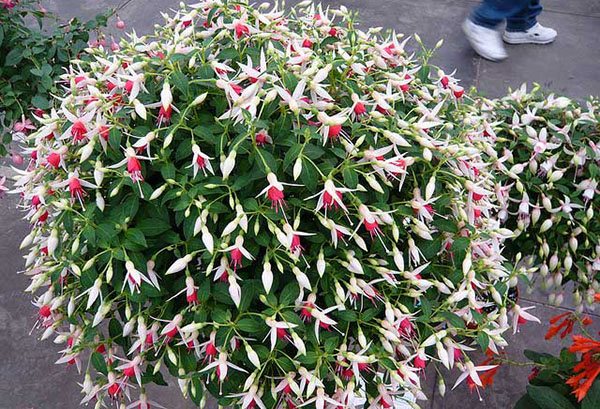

Outdoor hybrid varieties
Coloring of flowers "ballerina" pleases with a variety - from variegated light and blue monochromatic tones to bright, from pale pink to lilac shades.
For garden design, varieties with large, strongly growing, straight shoots are most often used. They undoubtedly need careful care, but prettier from year to year.
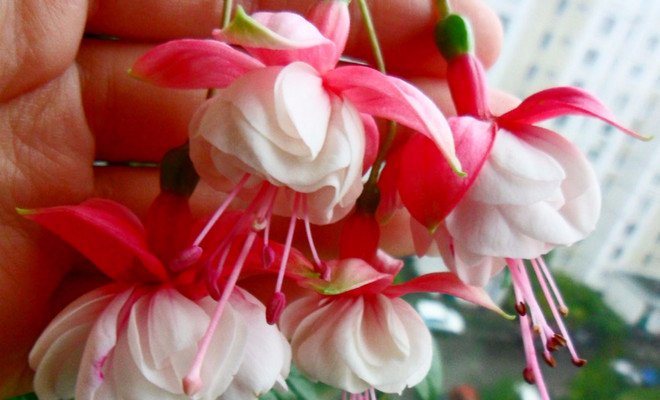

All fuchsias have their own lighting requirements, but most of them cannot tolerate direct sunlight. Therefore, it is better to plant these plants in shaded areas.
For sunny areas and outdoor areas, varieties such as Hawaiian Aloha and Coral are suitable. They bloom luxuriously even under the scorching sun, but require more stringent care.
Compact and ampelous bushes are best grown in pots in the garden. These species are short-lived and begin to grow upward over time.
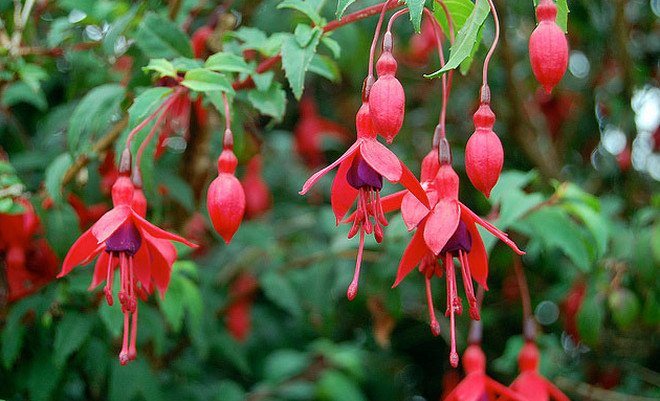

Therefore, when growing them, it is necessary to monitor the condition of the plant, periodically replacing old lignified bushes with young ones. They can also be placed in the garden as a decorative group or to decorate a balcony or terrace with them.
Ivy, balsam and begonia will be excellent neighbors for hybrid fuchsia grown in flowerpots.
For the winter, the street "ballerina" can be dug up and left until spring in a cool room with enough light. Basically, the following fuchsia varieties are suitable for the garden:
- Beacon... A bush 50-60 cm high with medium-sized dark green toothed leaves. The flowers are bright red glossy.
- Gartenmeister bonstedt... A bush that is quite resistant to sunlight. Differs in racemose salmon-orange flowers. The leaves are medium-sized, green.
- Koralle... An upright plant with vigorous shoots and early, abundant and fairly long flowering. The leaves are large, green. The flowers are medium, salmon-orange in color.
- Cliantha... Medium-sized bushy plant, growing up to 30-35 cm in height. It has medium-sized dark green leaves and medium-sized lilac double flowers.
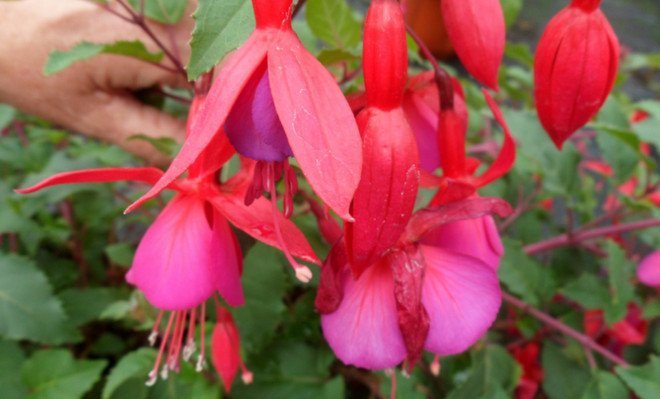

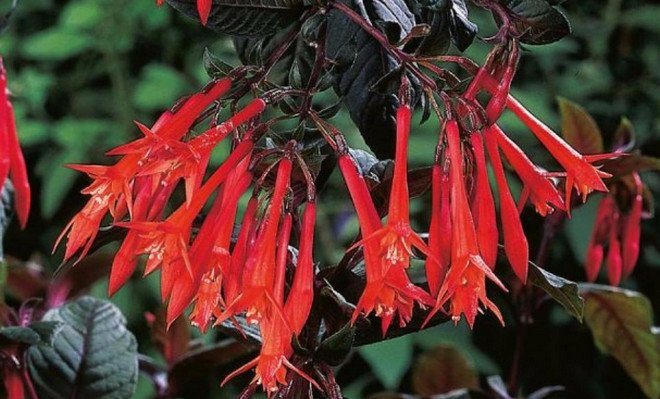

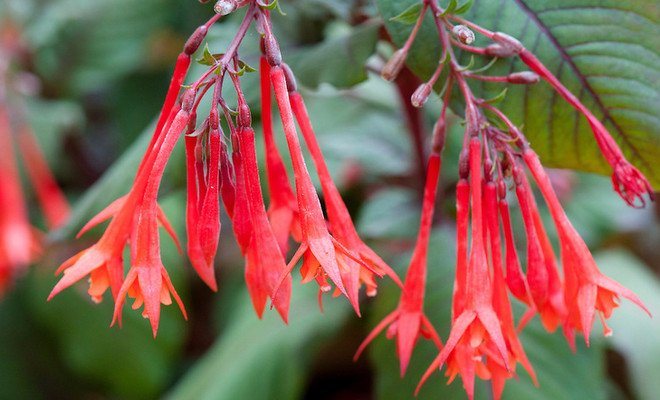

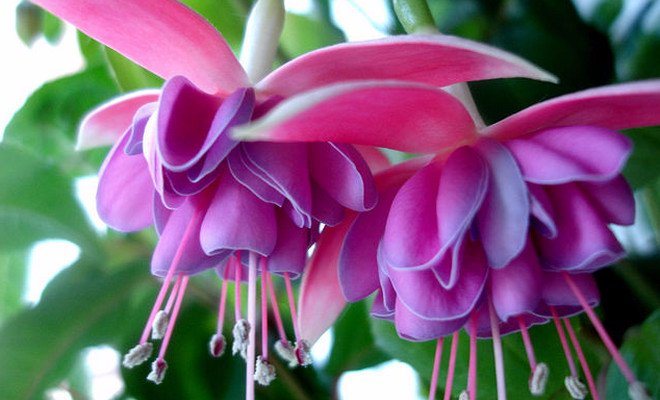

- Comet... Medium bush of American origin. Differs in rich green leaves and rather large pink-red double flowers with a lilac skirt.
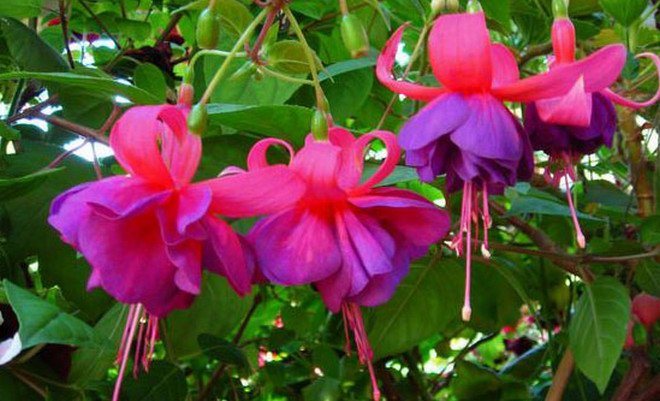

- Fey... A profusely flowering medium-sized variety with medium-sized green leaves. It blooms with white flowers with green edging, dressed in blue skirts.
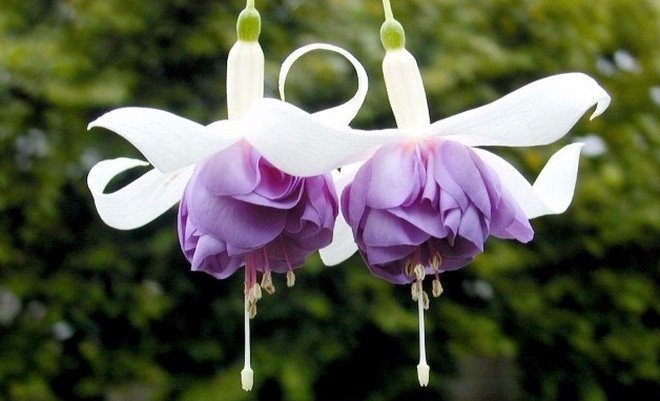

- Granada... Semi-ample, abundantly flowering plant. The foliage is large, light green with reddish veins. The flowers are large, deep red.
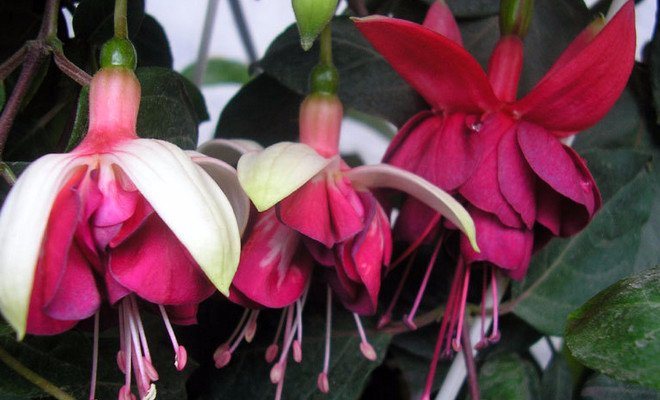

- Icicle... Ampelny vigorous and fast-growing variety with light green leaves. It blooms with large double white flowers.
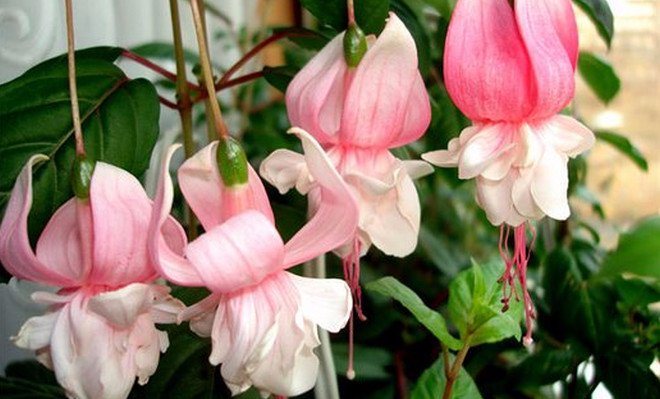

- Margarita... Semi-ampelous, weakly branching variety, characterized by long flowering. Leaves are dense, green. It blooms with large double flowers of a cream shade.
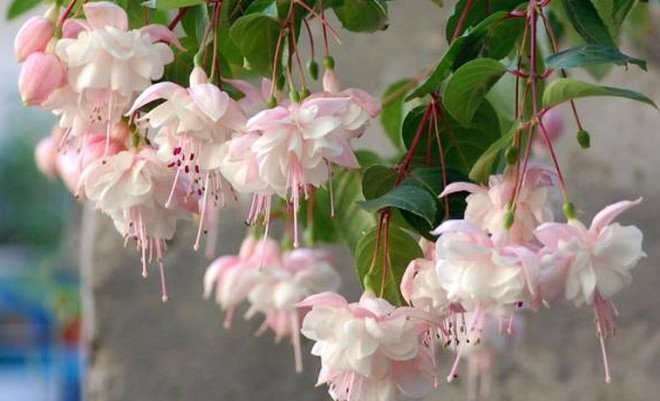

- Queen... Medium-sized form 45-50 cm high. The foliage is glossy, dark green, with jagged edges. The flowers are large, double, white with a red skirt.
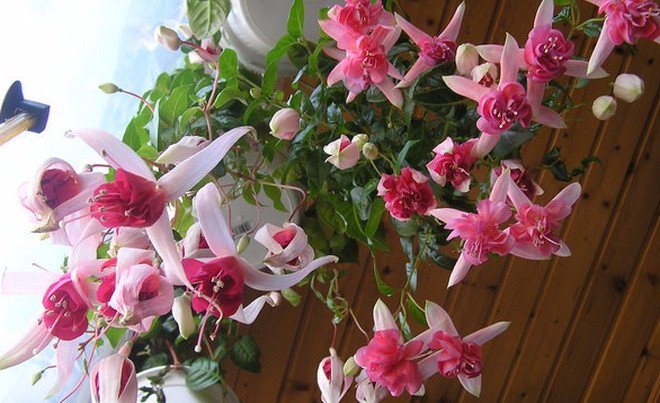

- Supersport... A bushy medium-sized variety, no more than 35 cm high. Differs in large, densely double rich red flowers with a lilac skirt.
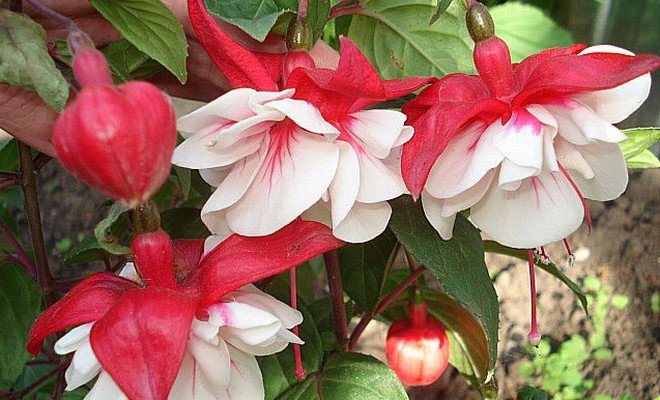

In winter
During winter dormancy
fuchsia needs cold content to rest and build up strength for further growth and abundant flowering. The ideal temperature for wintering is + 5 ... + 12 ° С, most often it can be created on a warm glazed loggia. If it is not possible to take the plant out to the loggia, it is kept on the coldest windowsill in the apartment - close to the window, away from the batteries and not far from the window that is slightly open for ventilation. If it is too hot in the room, you can separate the plant from the room with a polyethylene screen, like a greenhouse, to keep the cold around it from the window as much as possible. Fuchsias wintering on the windowsill really need additional lighting: due to too warm content, it will not be possible to completely stop the growth of shoots, which stretch out from lack of light, weaken and become very susceptible to disease. Shoots growing in winter are regularly pinched, preventing them from developing, so that the plant does not waste energy on them. In winter, fuchsias are watered as needed, preventing the earthen coma from drying out. Fertilizers are not applied in order not to stimulate growth.
Top dressing.
Fuchsias over the summer gain a large leaf mass and spend a lot of energy on abundant flowering, so they are very responsive to feeding. In the spring, you need to apply a complex fertilizer with a high nitrogen content weekly in small quantities. Any fertilizer for flowering plants (Pokon, Kemira-Lux) is suitable for setting buds. Some amateurs write that fertilizers for tomatoes are also well suited “Ripen! For peppers and tomatoes. " An explosion of flowering is caused by fertilizing with organic fertilizers from the Plant series.
Fuchsia: care in winter


Florists do not always undertake to work with fuchsia, because they do not know how to store fuchsia in winter. They are afraid that they will not be able to cope with the storage of this magnificent plant during its dormant period.
There are several ways to store fuchsia in winter, which depend on the type of flower, on the ability and desire to preserve the plant.
Nowadays there are varieties that can winter outdoors and varieties that can only be stored in greenhouses. There are also such varieties of fuchsia that will delight with flowers all year round, if certain conditions are created for them.
Fuchsia is a very hardy plant, but it can be ruined by complete drying out or very strong freezing. Nowadays, new frost-resistant fuchsia varieties appear, which can be left to winter outside if the frost does not exceed 20 degrees.
In addition, such fuchsia is better to spend the winter outdoors than to be in a warm apartment with low light.
Fuchsia care in cold weather
When the air temperature drops to 5-7 degrees (usually at the beginning of November), the plant for wintering must be transferred to a room with a similar temperature. Fuchsia hibernates in a cool room, both without light and with light.
For this, a basement, an insulated garage, a glazed balcony are suitable, and if there is nothing like that, a window sill will do. A young plant is placed on the southern windows (this is the best location) closer to the glass, away from the battery. With this arrangement, the fuchsia will grow slowly and not stretch.
On the northern windows, the plant needs illumination, otherwise it will stretch out and turn pale.
For proper growth, the plant must be fertilized and pinched. Although the cultivation of fuchsia is a troublesome business, cuttings harvested in the fall already become full-fledged young flowering bushes in the spring.Young green shoots should be cut for cuttings.
Fuchsias usually bloom until December, after which they completely or partially shed their leaves and buds. In February, active growth and flowering of fuchsia begins. This is the best time for grafting.
If you decide to leave fuchsia for the winter outside, then at the first frost it should be cut off, leaving shoots 5-10 cm long.
If fuchsia grew in a hanging flowerpot, then the plant must be removed and buried in the ground, covered with a thick layer of peat or dry oak leaves on top. To avoid moisture ingress, everything is covered with plastic wrap from above.
This is how cold-resistant fuchsia varieties such as Coralline, Dollar Princess, Royal Velvet, White Fairy, General Monk, Mrs. Popple, Preston Guild, Baby Blue Eyes.
The most optimal temperature for keeping fuchsia in winter is 5-10 degrees Celsius. Under such conditions, the plant becomes undemanding to sunlight, stops growing and goes into a state of dormancy. If the temperature rises, you need to increase the lighting.
It will not be necessary to light up the plant if you keep it in the south-west, south-east or south window at a temperature of 15 degrees.
When fuchsia is kept in higher temperatures, it must be supplemented, otherwise the plant will continue to grow, and in spring it will be weakened.
How to keep fuchsia in winter on a balcony or glazed loggia?
First, we insulate and glue the windows on the loggia. Fuchsia for the winter remains in a pot or box in the form of cut bushes or cuttings, which are rooted in the fall. The boxes are covered with sawdust or sand.
Water the plant as needed or moisten the sawdust. During the winter, the young fuchsia will stiffen, gain strength and in the spring a strong plant will grow from it. If the watering regime is violated, the fuchsia will shed the buds.
It can also happen if the fuchsia is rotated or rearranged during the flowering period.
Fuchsia species
Fuchsia thin (Fuchsia macrostemma). Synonyms: Fuchsia magellanic variety thin (Fuchsia magellanica var.macrostemma), Fuchsia graceful (Fuchsia gracilis) - evergreen shrubs 1-3 m in height, with pubescent thin and often reddish branches. Homeland - Chile. Leaves are opposite, oval-lanceolate, 2-5 m long and 1-2 cm wide, pointed, finely toothed at the edges, glabrous. The petiole is long, 4-5 cm long, red. The flowers are collected in multi-flowered racemes, on thin pedicels, drooping, purple. The petals are purple, the stamens are prominent. Abundant and long flowering July-September. Highly decorative look.
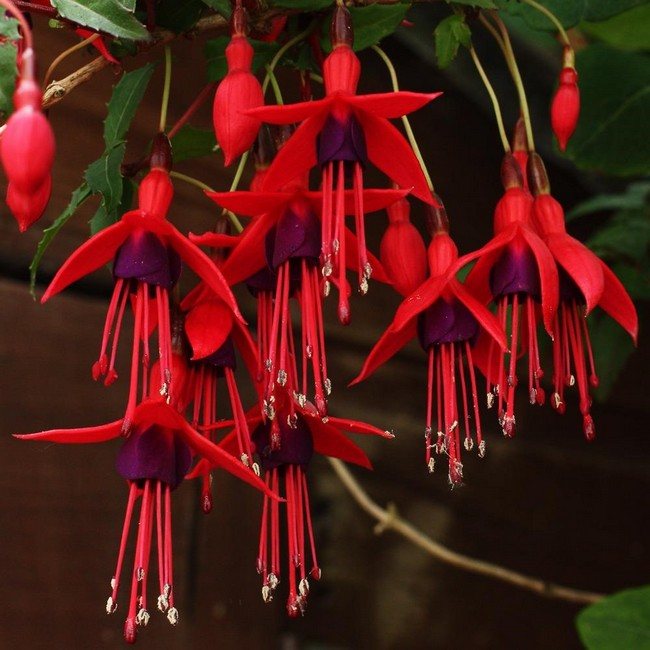

Fuchsia brilliant (Fuchsia fulgens) - evergreen shrubs 1-2 m tall, densely branched, bare branches. Homeland in the mountains in Mexico. Leaves are opposite, cordate-oval, oblong-ovate, large, 15-20 cm long and 8-12 cm wide, finely toothed at the edges, glabrous. Flowers are collected in dense apical drooping racemes, scarlet-red, corolla tube up to 10 cm in length, tapering towards the base, petals up to 1 cm in length, sepals are short, with whitish or greenish top, stamens are prominent. The fruit is an edible berry. Abundant and long flowering June-August. Highly decorative look.
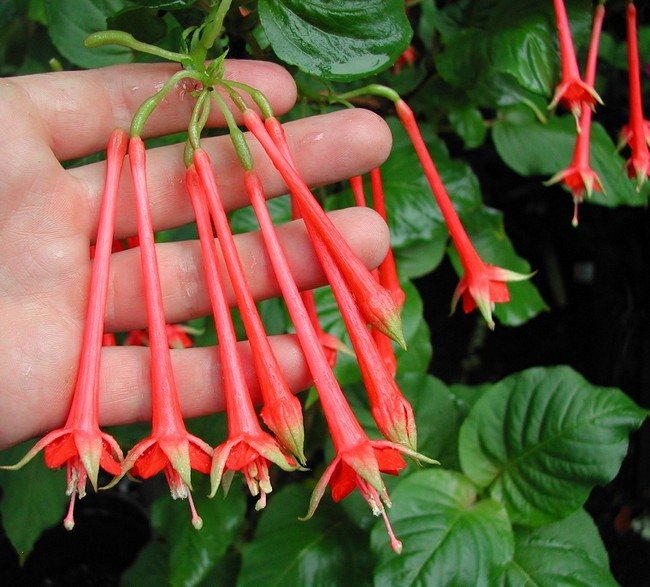

How to properly cut fuchsia growing in a flower bed and in an apartment for the winter?
In the fall, the owners have a lot of work both in the flower garden and with houseplants. If you do not prune fuchsia in time for the winter, the flower will not rest in the cold season and in the summer will not be able to fully please you with huge caps of inflorescences. A tropical shrub needs warmth (but too high temperatures are contraindicated for it), high air humidity, and shading. Help him survive the unusual cold winter - and in the spring the entire crown will be covered with large multi-colored inflorescences.
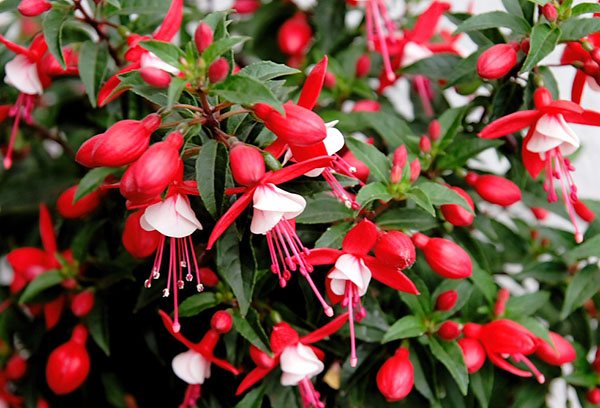

Possible problems
Problems that a florist may face:
- Fuchsia does not bloom. The reasons for this:
- In the winter, the flower was warm.
- Excessive watering.
- In warm weather, watering was rare or there was not enough top dressing.
- There is little light during the growing season.
- The leaves of the flower wither, dry and fall off. The reasons for this:
- The air in the room is dry, the soil lacks moisture.
- Fuchsia buds do not open. The reasons for this:
- Excessive moisture.
Watering
Improper watering is the most common cause of fuchsia death. They do not tolerate overflow or overdrying of an earthen coma. It is necessary to water the plants evenly, but not in any case. A flooded plant may look quite healthy for a few more days, and then suddenly it will drop leaves and die. This is especially dangerous in the heat, when abundant watering is required, and in cool times, when the watering exceeds the amount of liquid that can evaporate. If you have a lot of plants, approach watering individually. If the soil in any pot remains moist after the previous watering, in no case do not water it and watch it. It is better to spray the plants more often, especially in hot and dry weather, and water only as needed. Rooted cuttings and newly transplanted plants need particularly gentle watering.
What kind of land does fuchsia love?
How to grow fuchsia from seeds at home
The land for fuchsia needs fertile, it should contain a large amount of humus. It must also retain water well, since the soil must not be allowed to dry out, it must be constantly moistened.
What soil is needed
The easiest option is a slightly acidic soil for flowering plants, which can be easily purchased at any flower or horticultural store. If you have the time and desire, then you can prepare a mixture for planting and growing yourself.
There are several options:
- two parts of peat, three parts of deciduous land, one part of sand;
- two parts of greenhouse land, three parts of clay-grain land, one part of sand. A small amount of peat crumb will be an excellent addition to this combination;
- an equal combination of the following components: humus, peat, sand, leaf and sod land.
All of these options will give the required low level of acidity, close to neutral, level of friability. They will not allow water to stagnate, but they will also prevent a lack of it (with proper watering).
What are fuchsias?
The owners love fuchsia for a huge variety of species, lush flowering and unpretentious care. Breeders have bred a variety of varieties for outdoor flower beds, and for growing on a windowsill, and for hanging pots.
Depending on the purpose of the plant, you can choose one of three forms of the bush:
- erect, with shoots directed upwards;
- ampelous, the branches of which fall down in a cascade;
- semi-ampel, in which the shoots stretch upward, and when flowering, under the weight of the lush caps, they bend and hang below the bottom of the vessel.
Fuchsia bloom lasts from spring to autumn and is striking in its variety. The plant begins to release buds at a tender age, they can be seen even on small cuttings. Some varieties form inflorescences, collected in clusters, with various colors, from white to purple. The calyx of the flower can reach a length of 10 cm, there are terry varieties with a large number of petals, there are more modest, but no less charming inflorescences.
When growing ampelous forms, a tall flowerpot covered with decorative lashes looks very beautiful. But if the vessel is low, the middle appears to be empty. Do not forget that breeders have bred different types of fuchsias, this will help you create a complete composition. Plant a stalk of an erect variety in the center of the flowerpot; it will grow into a lush bush that adorns the top of the flower garden.
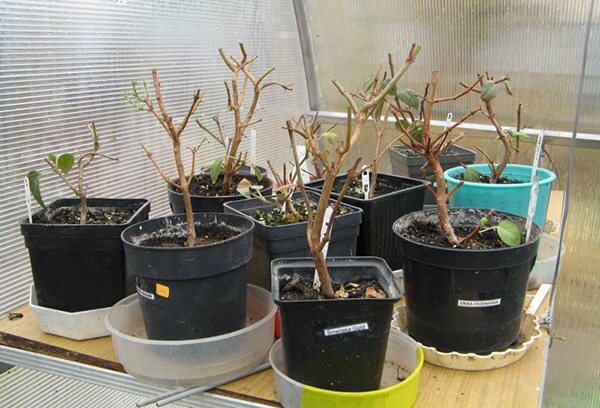

Fuchsia boliviana
The plant came to us from Bolivia, Argentina, Peru. This fuchsia is considered one of the most beautiful and spectacular species. Reaches one meter in height. The leaves are large, pleasantly velvety to the touch.Bolivian fuchsia flowers are collected in extraordinary bunches. They are distinguished by the huge size of the peduncles (up to 30 cm), on which the flowers hanging down are gracefully attached. Flowers are red and white. This plant prefers to grow in shade or partial shade. Humidity is also important. He prefers to spend the winter in warm rooms, as he does not like cold temperatures. Bolivian fuchsia blooms from early March to late April.
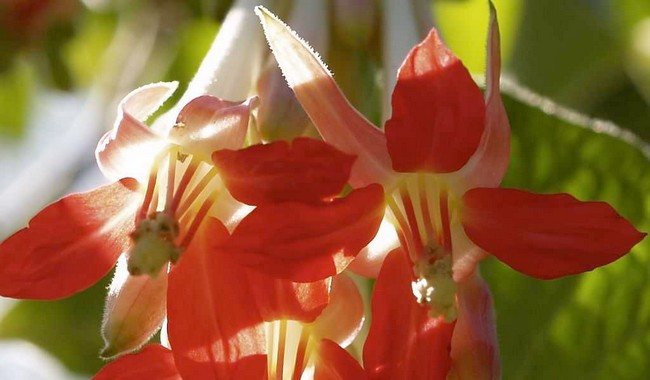

Propagation by cuttings
This is the most natural and reliable method to propagate a culture and can be done all year round. However, it is more correct, nevertheless, to carry it out in the spring. Take only young cuttings, as woody cuttings will take much longer to root.
Take a 10-20 cm long stalk and remove the lower leaves. Place it in water that has stood for several days before, and wait for the roots to appear. To create greenhouse conditions, cover with a plastic bag or bottle. Roots will be nailed on the fifth day. There is no need to wait for large roots, plant the finished seedling in a prepared pot with a substrate. Some daredevil growers plant cuttings of the plant directly into the ground, skipping the rooting stage. But they also do not refuse from an impromptu greenhouse.
In the fall, the plant prepares for the hibernation period. Life is slowing down, so from September to January it is not worth propagating the culture.
Temperature
During the period of active growth and flowering (in spring and summer), fuchsia feels better at a temperature of 22-24 degrees. In summer, especially in August, it can be taken out into the fresh air. However, when the temperature rises above 30 degrees, the plant may begin to shed flowers, then leaves, and may even dry out.
High air temperature is destructive for fuchsia
Therefore, under such conditions, the flower must be protected from the sun's rays and try to put it in a cooler place. In hot conditions, sensitive roots must be protected. A large ceramic pot is the best option because its plastic counterpart heats up very quickly.
In winter, the optimum temperature for fuchsia is 5-12 degrees.... Such conditions can be on a cold windowsill, a glazed and insulated balcony, or near balcony doors. At this time, the plant is dormant, and the low temperature of the content is the key to abundant flowering in the subsequent growth period.
Fuchsia can tolerate room temperature in winter. But then the flower sheds part of the leaves and stretches out strongly, and in the spring it will bloom weakly or will not please with buds at all.
Fuchsia loves fresh air, but does not tolerate drafts... When airing a room, it is important to consider these factors.

